Content [show]
 Thuja danica is a plant with excellent decorative properties. Growing this dwarf variety is possible at home, without the involvement of specialists. It is undemanding to the conditions of planting and care, therefore it grows well in the open field in the climate of the middle zone.
Thuja danica is a plant with excellent decorative properties. Growing this dwarf variety is possible at home, without the involvement of specialists. It is undemanding to the conditions of planting and care, therefore it grows well in the open field in the climate of the middle zone.
Description: varieties and varieties of western thuja
Danica is one of the thuja species of the western spherical cypress family. Dwarf tree varieties have a neat rounded crown, which looks spectacular in the photo in open ground and in a greenhouse. It is also resistant to frost and city dust. The crown grows 4-5 cm per year, up to about 60-80 cm, and is distinguished by its durability. Other characteristics of thuja Danica:
- the width of an adult plant is up to 1 m;
- dense crown;
- twigs grow vertically;
- needles are thin, scaly, soft, deep green;

Thuja danica is a spherical shrub
- does not bloom, occasionally produces small rounded bumps;
- shoots are short, light green;
- the bark is gray, with a brown or red tint;
- the roots lie at the surface.
Attention! The needles of annual seedlings consist of small and thin juvenile needles. And only with growing up are they replaced by a scaly layer.
Among all the variety of western thuja in Russia, the variety Danika Aurea is still in demand. It is undersized, up to 40 cm. Even in the photo it is noticeable that Aurea has lighter and narrower corners. This variety is able to withstand -29 ° C in snowy winters.
Correct planting
In matters of cultivation and care, thuja is unpretentious. Planting outdoors in a sunny area will help form a perfect, healthy crown. Also, the place should be sheltered from the wind. The plant loves light, slightly acidic soils.
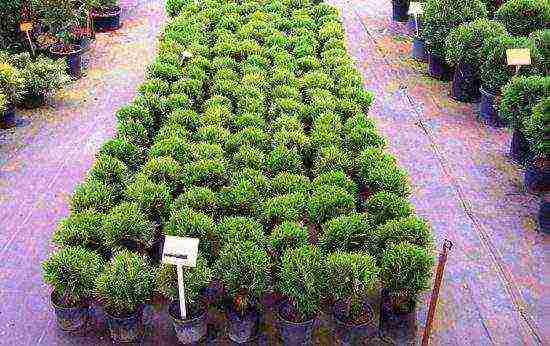
Plant the plant away from drafts
Landing is carried out as follows:
- Prepare the substrate in advance. Mix 50% leaf or turf soil, 25% each sand and peat.
- Make a hole 60-80 cm.
- Fertilize the soil with nitroammophos. One seedling - about 500 g.
- Dig in the tree. The root collar should be flush with the soil.
Advice. If the soil in your area is heavy or there is close groundwater, for cultivation, organize a drainage layer of rubble with sand at the bottom of the hole, about 15-20 cm.
Thuja Danica care
Young plant care involves watering once a week. Give the seedling a drink (10–20 liters of water) and water the greens. From the second month after planting, the watering level is reduced. In drought, the amount of water, on the contrary, can be increased.
Advice. Follow each watering with shallow loosening. Also make and update your mulch regularly. It can be collected from dry humus or peat, or from wood chips.
Thuja western normally tolerates frosts, only one-year olds need to be sheltered in open ground. Gardeners use thin burlap. But the plant does not tolerate heat well. In the summer, a shadow for her can be created artificially. Spring care begins with pruning. Remove dry and dead parts, trim the ball shape.

Thuja responds well to feeding
Fertilizer and tree feeding
Ornamental crops can grow without fertilizers. But top dressing will give its crown density and rich color. The technology is simple:
- Organic - during spring and June. Apply fertilizer around the plant under a shallow digging (up to 10 cm).
- Mineral dressing: saltpeter and wood ash. Apply at the same time, alternating with organic.
Advice. Complex mineral mixtures are also used as fertilizers: 50-60 g per 1 sq. m.
Reproduction of a plant at home
If you want to get more specimens of western thuja for decorating plots, work on self-propagation of the plant. The only effective way is grafting. Material is obtained from lignified or semi-lignified shoots. The optimal time for planting and rooting is autumn.
The breeding process goes like this:
- Build a greenhouse. Cuttings root in high humidity conditions. In this case, the walls of the greenhouse should be transparent in order to give the plant abundant lighting.
- Cut off a suitable shoot about 50 cm long. For reproduction, it must have a heel shoot.Remove the needles from the bottom of the cutting and soak in a root stimulator.
- Prepare the soil with equal shares of turf, sand and peat.
- When planting, deepen the cutting by 3 cm.
- Open the greenhouse for 15–20 minutes. in a day. Spray the cuttings.
Attention! If propagation is done correctly, expect roots to appear in about a month. In spring, the seedlings will be ready for open ground.
Diseases and pests of thuja western Danica
The plant is resistant to pests and diseases, but the risk of damage still exists:
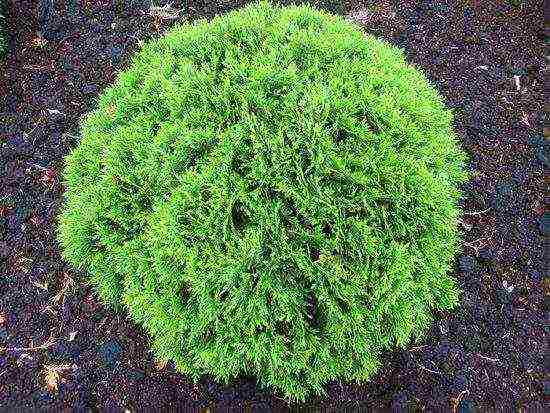
Healthy plant is resistant to pests
- Aphids and spider mites cause yellowing of the needles.
- Due to the needles gnawing insects, the needles become brown, and the tops of the shoots dry out.
- Root pests cause a general deterioration in the condition of the plant and the loss of its decorative qualities.
Attention! There are many chemical preparations for protection against harmful insects. It is important to determine the nature of the disease in order to choose the right treatment.
Diseases of thuja western Danica:
- brown mold;
- trunk rot;
- rotting roots.
The remedy for any rot is radical - burning the affected plant so that the disease does not spread to other inhabitants of the garden. Prevention - spring spraying with fungicide. Brown mold, which manifests itself during spring thaws, is less aggressive. Destroy the dead parts of the tree. Care for healthy elements consists in antimicrobial spraying.
Thuja Danica and its combination with other plants
Growing thuja Danica is possible as an independent decorative element and in combination with other cultures. It looks great in the company of flowering shrubs in the front garden or as a hedge. Dwarf thuja decorate the lawns at the administration buildings. The best neighbor for Danica is the same plant. Although the right combination with other crops, for example, in a rock garden can be attractive. Sometimes, instead of a ball, the owners form bizarre figures from the bush.
All varieties of thuja Danica are decorative conifers that are great for northern latitudes. Proper care will help you get beautiful green balls from delicate needles.
Thuja Danica spherical: video
 Small compact varieties of thuja are extremely in demand in landscape design. Thuja western Danica - a plant with a dense rounded crown up to 80 cm high and about a meter in diameter belongs to dwarf forms.
Small compact varieties of thuja are extremely in demand in landscape design. Thuja western Danica - a plant with a dense rounded crown up to 80 cm high and about a meter in diameter belongs to dwarf forms.
Such an evergreen shrub will definitely find a place near an alpine hill, in a decorative border, in group plantings among flowering perennials and as a solo plant among stones or ground cover species.
Description of Tui Danica
 A slow-growing variety, reaching its maximum size not earlier than 15 years of age, was bred in the middle of the last century by Danish botanists. Since then, thuja has become one of the most popular when decorating small areas where it is difficult to find a place for larger crops.
A slow-growing variety, reaching its maximum size not earlier than 15 years of age, was bred in the middle of the last century by Danish botanists. Since then, thuja has become one of the most popular when decorating small areas where it is difficult to find a place for larger crops.
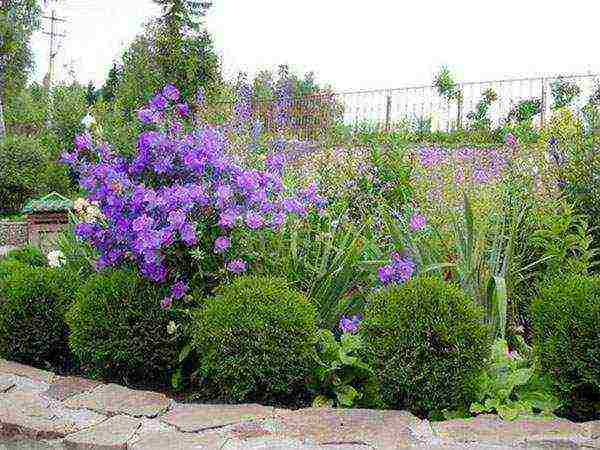 According to the description, thuja Danica is a coniferous evergreen shrub, the crown of which consists of many shoots densely covered with soft needles. Most of the branches are directed upward, which gives the small plant additional "fluffiness". Young needles covering the ends of the shoots are needle-shaped. Later, it takes the form of scales tightly adhering to the wood. In summer, the crown of thuja western Danica is painted in rich green tones. By the fall, the needles turn brown and remain so until spring.
According to the description, thuja Danica is a coniferous evergreen shrub, the crown of which consists of many shoots densely covered with soft needles. Most of the branches are directed upward, which gives the small plant additional "fluffiness". Young needles covering the ends of the shoots are needle-shaped. Later, it takes the form of scales tightly adhering to the wood. In summer, the crown of thuja western Danica is painted in rich green tones. By the fall, the needles turn brown and remain so until spring.
Plants are durable. With proper care, like other varieties, thuja Danica can reach the age of 150 years.
Of course, today there are no such old copies yet. But at the disposal of lovers of landscape design, thuja Danica Aurea appeared, even more original than the traditional plant. This shrub has not green, but bright golden needles. Withstanding frosts down to –29 ° C, it is just as winter-hardy and at the same time more dependent on sunlight.The unusual shade of the needles fades in the shade, and the crown of both the usual and the golden ephedra gradually loses its spherical shape, becoming loose, sloppy.
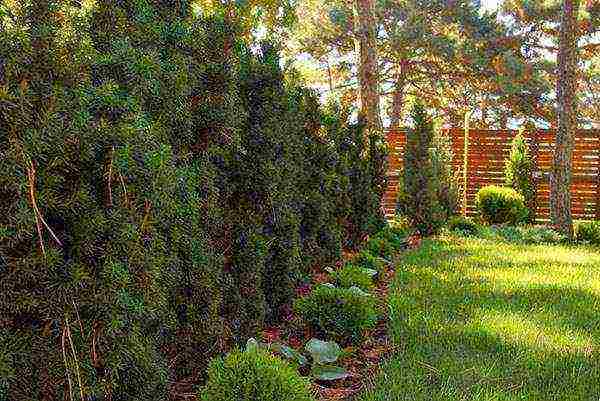 Like all conifers of this genus, this variety of thuja blooms almost imperceptibly. Occasionally appearing brownish-brown cones have a rounded shape and a diameter of no more than 6 mm. However, seeds are not suitable for reproduction. In culture, this compact form is only propagated by cuttings.
Like all conifers of this genus, this variety of thuja blooms almost imperceptibly. Occasionally appearing brownish-brown cones have a rounded shape and a diameter of no more than 6 mm. However, seeds are not suitable for reproduction. In culture, this compact form is only propagated by cuttings.
Planting and caring for the spherical thuja Danica
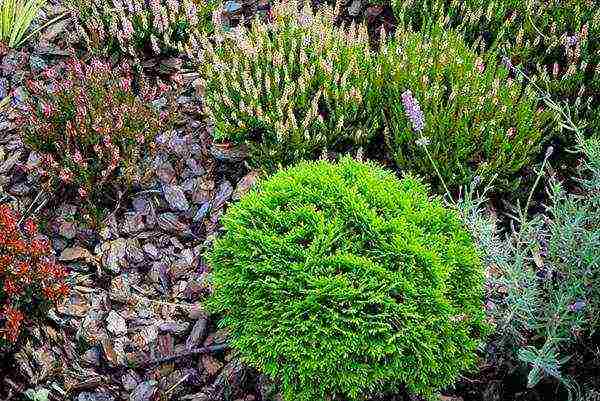 In order for the growing thuja to be lush and bright, it is important for it to find a suitable place. Conifers feel great in the sun and endure partial shade, but, falling under the dense crowns of trees or in the shade of a house, the plants risk losing their decorative effect.
In order for the growing thuja to be lush and bright, it is important for it to find a suitable place. Conifers feel great in the sun and endure partial shade, but, falling under the dense crowns of trees or in the shade of a house, the plants risk losing their decorative effect.
Therefore, an open sunny place with a loose, actively aerated soil is chosen for the spherical thuja Danica shrub. It is important that the root system of the plant does not suffer from close-lying or stagnant waters. Since young specimens are less resistant to cold weather and spring burns, the site must be protected from the wind:
- If thuja is to be planted for a curb, holes for shrubs are dug at a distance of 30 cm from each other. This will allow the crowns of neighboring plants to intersect and form a single, low wall.
- In single plantings, the western thuja Danica is planted at a distance of 50 cm from other plants. Such a measure will help the bush to form a beautiful, even spherical crown.
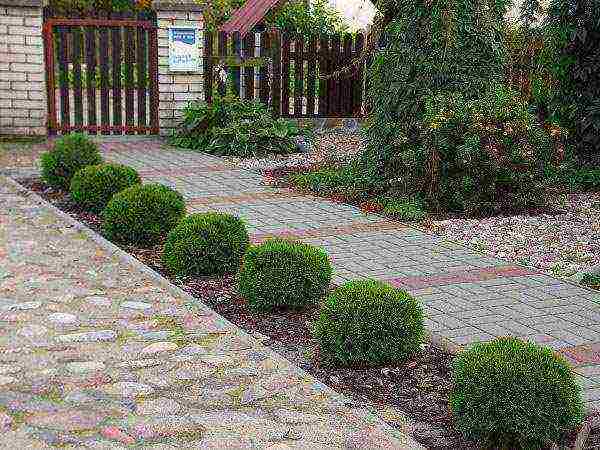 Tui can do without watering for a long time, but grow best on moist fertile soil. A bush planting hole is made a little larger than a root system in a container. At the bottom, drainage is made from broken brick, stone chips or expanded clay. The soil for filling the planting pit is mixed with minerals and well-rotted organic matter. After backfilling, the earth is easily tamped and watered, and the circle under the crown is thickly mulched with peat left over after mowing with grass, wood chips or other composition.
Tui can do without watering for a long time, but grow best on moist fertile soil. A bush planting hole is made a little larger than a root system in a container. At the bottom, drainage is made from broken brick, stone chips or expanded clay. The soil for filling the planting pit is mixed with minerals and well-rotted organic matter. After backfilling, the earth is easily tamped and watered, and the circle under the crown is thickly mulched with peat left over after mowing with grass, wood chips or other composition.
After planting, caring for Danika's thuja, as in the photo, consists in watering, adding mulch and monitoring the state of the crown.
In the hot season, the bushes should receive water. To wet the roots, 10–20 liters are poured under each plant. The soil under the thuja is carefully loosened and covered with mulch. In case of prolonged drought and heat, the crown can be irrigated with warm water.
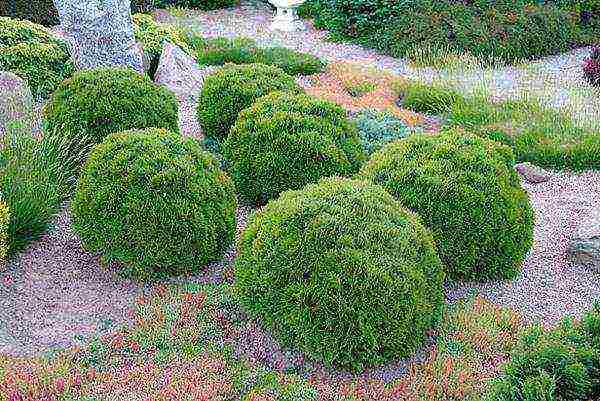 In the spring, conifers are fed with special mixtures that allow the needles to be as bright as possible.
In the spring, conifers are fed with special mixtures that allow the needles to be as bright as possible.
A characteristic feature of the plant is its low growth rate, leaving only 4–5 cm in width and height. Therefore, fertilizers do not have a serious effect on the growth of the crown.
Usually, the thuja Danika, appreciated in landscape design, does not need special formative pruning. However, you cannot do without pruning old, dead or improperly overgrown branches. Sanitary pruning is done in early spring. During her:
- remove dry branches;
- cut branches broken by wind or snow,
- cut off the needles, dried up by the bright spring sun.
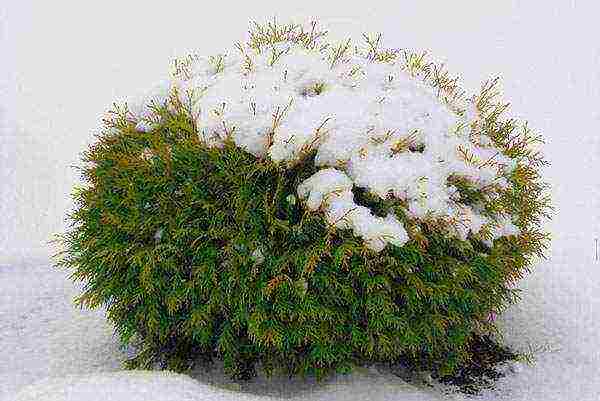 It is better to cover young plants in autumn with spruce branches, which will protect them from frost and ubiquitous rodents, which often take a fancy to the space under the crown for a winter home.
It is better to cover young plants in autumn with spruce branches, which will protect them from frost and ubiquitous rodents, which often take a fancy to the space under the crown for a winter home.
In frosts, thuja bushes are covered with snow. Covering with burlap or non-woven material will help to guarantee a bright color of the crown of a field of snowless winter.
Tuya Danika in landscape design
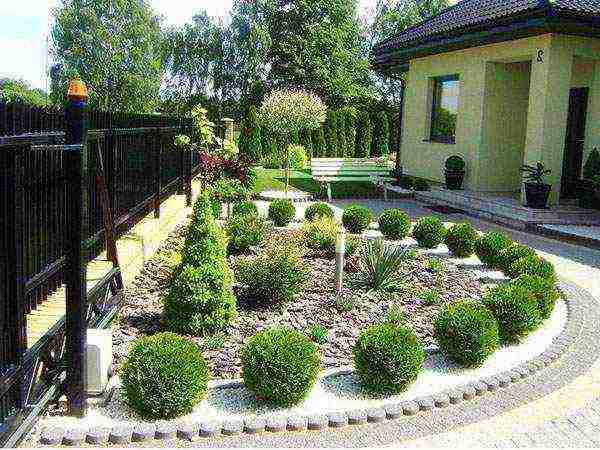 A low-growing thuja with a crown that has a natural spherical shape could not but find its place in landscaping.
A low-growing thuja with a crown that has a natural spherical shape could not but find its place in landscaping.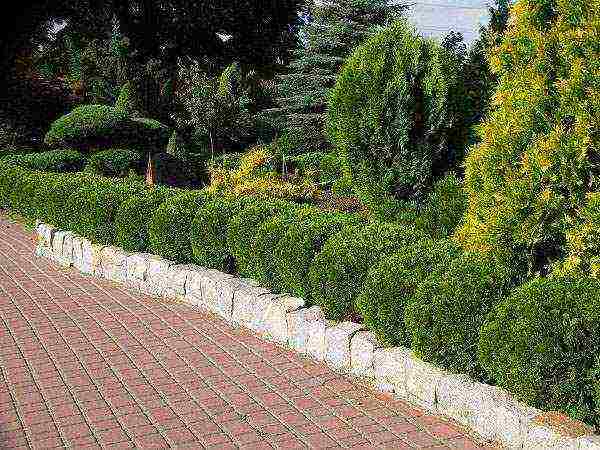
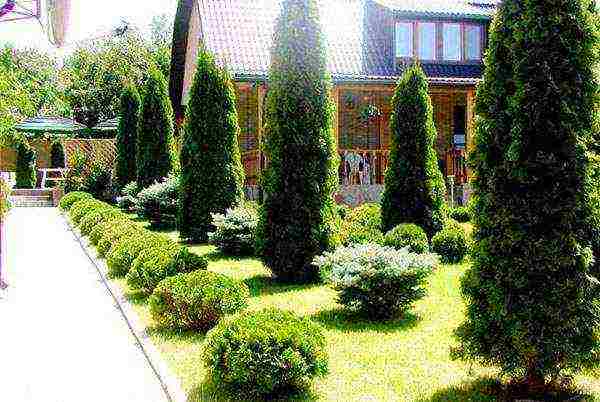 If larger species require a lot of space, complex care and regular haircut, the dwarf plant of thuja western Danica, as in the photo, can be easily imagined:
If larger species require a lot of space, complex care and regular haircut, the dwarf plant of thuja western Danica, as in the photo, can be easily imagined:
 An unpretentious decorative ephedra, even with such a modest size, invariably becomes an adornment of any garden, and its care does not take much time or effort for the gardener.
An unpretentious decorative ephedra, even with such a modest size, invariably becomes an adornment of any garden, and its care does not take much time or effort for the gardener.
Content
Thuja western Danica - planting and care, description, photo of spherical thuja in landscape design, video
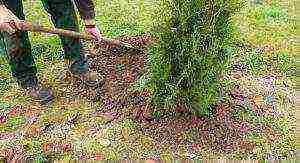
Small compact varieties of thuja are extremely in demand in landscape design. Thuja western Danica - a plant with a dense rounded crown up to 80 cm high and about a meter in diameter belongs to dwarf forms.
Such an evergreen shrub will definitely find a place near an alpine hill, in a decorative border, in group plantings among flowering perennials and as a solo plant among stones or ground cover species.
Description of Tui Danica
A slow-growing variety, reaching its maximum size not earlier than 15 years of age, was bred in the middle of the last century by Danish botanists. Since then, thuja has become one of the most popular when decorating small areas where it is difficult to find a place for larger crops.
According to the description, thuja Danica is a coniferous evergreen shrub, the crown of which consists of many shoots densely covered with soft needles. Most of the branches are directed upward, which gives the small plant additional "fluffiness".
Young needles covering the ends of the shoots are needle-shaped. Later, it takes the form of scales tightly adhering to the wood. In summer, the crown of thuja western Danica is painted in rich green tones.
By the fall, the needles turn brown and remain so until spring.
Plants are durable. With proper care, like other varieties, thuja Danica can reach the age of 150 years.
Of course, today there are no such old copies yet. But at the disposal of lovers of landscape design, thuja Danica Aurea appeared, even more original than the traditional plant. This shrub has not green, but bright golden needles.
Withstanding frosts down to –29 ° C, it is just as winter-hardy and at the same time more dependent on sunlight. The unusual shade of the needles fades in the shade, and the crown of both the usual and the golden ephedra gradually loses its spherical shape, becoming loose, sloppy.
Like all conifers of this genus, this variety of thuja blooms almost imperceptibly. Occasionally appearing brownish-brown cones have a rounded shape and a diameter of no more than 6 mm. However, seeds are not suitable for reproduction. In culture, this compact form is only propagated by cuttings.
Planting and caring for the spherical thuja Danica
In order for the growing thuja to be lush and bright, it is important for it to find a suitable place.Conifers feel great in the sun and endure partial shade, but, falling under the dense crowns of trees or in the shade of a house, the plants risk losing their decorative effect.
Therefore, an open sunny place with a loose, actively aerated soil is chosen for the spherical thuja Danica shrub. It is important that the root system of the plant does not suffer from close-lying or stagnant waters. Since young specimens are less resistant to cold weather and spring burns, the site must be protected from the wind:
- If thuja is to be planted for a curb, holes for shrubs are dug at a distance of 30 cm from each other. This will allow the crowns of neighboring plants to intersect and form a single, low wall.
- In single plantings, the western thuja Danica is planted at a distance of 50 cm from other plants. Such a measure will help the bush to form a beautiful, even spherical crown.
Tui can do without watering for a long time, but grow best on moist fertile soil. A bush planting hole is made a little larger than a root system in a container. At the bottom, drainage is made from broken brick, stone chips or expanded clay.
The soil for filling the planting pit is mixed with minerals and well-rotted organic matter.
After backfilling, the earth is easily tamped and watered, and the circle under the crown is thickly mulched with peat left over after mowing with grass, wood chips or other composition.
After planting, caring for Danika's thuja, as in the photo, consists in watering, adding mulch and monitoring the state of the crown.
In the hot season, the bushes should receive water. To wet the roots, 10–20 liters are poured under each plant. The soil under the thuja is carefully loosened and covered with mulch. In case of prolonged drought and heat, the crown can be irrigated with warm water.
In the spring, conifers are fed with special mixtures that allow the needles to be as bright as possible.
A characteristic feature of the plant is its low growth rate, leaving only 4–5 cm in width and height. Therefore, fertilizers do not have a serious effect on the growth of the crown.
Usually, the thuja Danika, appreciated in landscape design, does not need special formative pruning. However, you cannot do without pruning old, dead or improperly overgrown branches. Sanitary pruning is done in early spring. During her:
- remove dry branches;
- cut branches broken by wind or snow,
- cut off the needles, dried up by the bright spring sun.
It is better to cover young plants in autumn with spruce branches, which will protect them from frost and ubiquitous rodents, which often take a fancy to the space under the crown for a winter home.
In frosts, thuja bushes are covered with snow. Covering with burlap or non-woven material will help to guarantee a bright color of the crown of a field of snowless winter.
Tuya Danika in landscape design
A low-growing thuja with a crown that has a natural spherical shape could not but find its place in landscaping.
If larger species require a lot of space, complex care and regular haircut, the dwarf plant of thuja western Danica, as in the photo, can be easily imagined:
- on a rocky hill in the tiniest garden;
- as part of a low, dense curb;
- in a container that is easy to put on a terrace or loggia, used to decorate a spacious hall or patio;
- on a flower garden framed by creeping perennials;
- against the background of tall ornamental-deciduous shrubs or bright tall flowers.
An unpretentious decorative ephedra, even with such a modest size, invariably becomes an adornment of any garden, and its care does not take much time or effort for the gardener.
Thuja western Danica: features of growing and reproduction of an ornamental plant
Thuja danica is a plant with excellent decorative properties. Growing this dwarf variety is possible at home, without the involvement of specialists. It is undemanding to the conditions of planting and care, therefore it grows well in the open field in the climate of the middle zone.
Description: varieties and varieties of western thuja
Danica is one of the thuja species of the western spherical cypress family. Dwarf tree varieties have a neat rounded crown, which looks spectacular in the photo in open ground and in a greenhouse. It is also resistant to frost and city dust. The crown grows 4-5 cm per year, up to about 60-80 cm, and is distinguished by its durability. Other characteristics of thuja Danica:
- the width of an adult plant is up to 1 m;
- dense crown;
- twigs grow vertically;
- needles are thin, scaly, soft, deep green;
Thuja danica is a spherical shrub
- does not bloom, occasionally produces small rounded bumps;
- shoots are short, light green;
- the bark is gray, with a brown or red tint;
- the roots lie at the surface.
Attention! The needles of annual seedlings consist of small and thin juvenile needles. And only with growing up are they replaced by a scaly layer.
Among all the variety of western thuja in Russia, the variety Danika Aurea is still in demand. It is undersized, up to 40 cm. Even in the photo it is noticeable that Aurea has lighter and narrower corners. This variety is able to withstand -29 ° C in snowy winters.
Correct planting of the plant
In matters of cultivation and care, thuja is unpretentious. Planting outdoors in a sunny area will help form a perfect healthy crown. Also, the place should be sheltered from the wind. The plant loves light, slightly acidic soils.
Plant the plant away from drafts
Landing is carried out as follows:
- Prepare the substrate in advance. Mix 50% leaf or turf soil, 25% each sand and peat.
- Make a hole 60-80 cm.
- Fertilize the soil with nitroammophos. One seedling - about 500 g.
- Dig in the tree. The root collar should be flush with the soil.
Advice. If the soil in your area is heavy or groundwater is located close, for cultivation, organize a drainage layer of rubble with sand at the bottom of the hole, about 15-20 cm.
Thuja Danica care
Young plant care involves watering once a week. Give the seedling a drink (10–20 liters of water) and water the greens. From the second month after planting, the watering level is reduced. In drought, the amount of water, on the contrary, can be increased.
Advice. Follow each watering with shallow loosening. Also make and update your mulch regularly. It can be collected from dry humus or peat, or from wood chips.
Thuja western normally tolerates frosts, only one-year olds need to be sheltered in open ground. Gardeners use thin burlap. But the plant does not tolerate heat well. In the summer, the shadow for her can be artificially created. Spring care begins with pruning. Remove dry and dead parts, trim the ball shape.
Thuja responds well to feeding
Fertilizer and tree feeding
Ornamental crops can grow without fertilizers. But top dressing will give its crown density and rich color. The technology is simple:
- Organic - during spring and June. Apply fertilizer around the plant under a shallow digging (up to 10 cm).
- Mineral dressing: saltpeter and wood ash. Apply at the same time, alternating with organic.
Advice. Complex mineral mixtures are also used as fertilizers: 50-60 g per 1 sq. m.
Reproduction of a plant at home
If you want to get more specimens of western thuja for decorating plots, work on self-propagation of the plant. The only effective way is grafting. Material is obtained from lignified or semi-lignified shoots. The optimal time for planting and rooting is autumn.
The breeding process goes like this:
- Build a greenhouse. Cuttings root in high humidity conditions. In this case, the walls of the greenhouse should be transparent in order to give the plant abundant lighting.
- Cut a suitable shoot about 50 cm long. For reproduction, it must have a heel shoot.Remove the needles from the bottom of the cutting and soak in a root stimulant.
- Prepare the soil with equal shares of turf, sand and peat.
- When planting, deepen the cutting by 3 cm.
- Open the greenhouse for 15–20 minutes. in a day. Spray the cuttings.
Attention! If propagation is done correctly, expect roots to appear in about a month. In spring, the seedlings will be ready for open ground.
Diseases and pests of thuja western Danica
The plant is resistant to pests and diseases, but the risk of damage still exists:
Healthy plant is resistant to pests
- Aphids and spider mites cause yellowing of the needles.
- Due to the needles gnawing insects, the needles become brown, and the tops of the shoots dry out.
- Root pests cause a general deterioration in the condition of the plant and the loss of its decorative qualities.
Attention! There are many chemical preparations for protection against harmful insects.
It is important to determine the nature of the disease in order to choose the right treatment.
Diseases of thuja western Danica:
- brown mold;
- trunk rot;
- rotting roots.
The remedy for any rot is radical - burning the affected plant so that the disease does not spread to other inhabitants of the garden. Prevention - spring spraying with fungicide. Brown mold, which manifests itself during spring thaws, is less aggressive. Destroy the dead parts of the tree. Care for healthy elements consists in antimicrobial spraying.
Thuja Danica and its combination with other plants
Growing thuja Danica is possible as an independent decorative element and in combination with other cultures. It looks great in the company of flowering shrubs in the front garden or as a hedge.
Dwarf thuja decorate the lawns at the administration buildings. The best neighbor for Danica is the same plant. Although the right combination with other crops, for example, in a rock garden can be attractive.
Sometimes, instead of a ball, the owners form bizarre figures from the bush.
All varieties of thuja Danica are decorative conifers that are great for northern latitudes. Proper care will help you get beautiful green balls from delicate needles.
Thuja Danica spherical: video
The unpretentious thuja western Danica adorns the landscape all year round
The evergreen coniferous shrub gives the landscape a beautiful look in all seasons. Hatched in Denmark thuja western danica (Thuja occidentalis Danica) - a dwarf spherical shrub of the cypress family, delighted landscape designers with unpretentiousness to light growing conditions and undemanding to soil moisture.
Description of the variety
The name of the variety Danika of a coniferous shrub of the western thuja species reflected country of selection... The variety is characterized by small bushes - up to 80 cm in height and width. Danika has a lifespan of about 200 years, the tree grows very slowly, adding up to 5 cm in height and up to 4 cm in width in a year. The variety belongs to the most miniature spherical thujas.
Thuja branches with small needles are directed upwards. Coniferous needles are soft to the touch. The plant rarely blooms, a small half-centimeter brown cone appears in the place of a faded inflorescence.
Planting and leaving
Danika is planted in full sun and partial shade. Thuja, receiving a sufficient amount of light, has a more lush and elegant crown. The shrub is not picky about the composition of the soil, the nutritional value and moisture of the soil are important for it. Like all western thujas, Danica loves watering, but can withstand the temporary dryness of the soil. It is desirable for the soil pH to be between 5 and 7.
Danica can be grown by cuttings, from seeds, but the plant grows slowly, and growing by these methods requires long-term care. The optimal solution is to grow western thuja Danica with seedlings.
How much are the seedlings
The seedlings are sold in nurseries, they are acclimatized to growing conditions, thanks to proper care they are healthy and have a well-groomed appearance.
The range of prices for seedlings is large - from 850 to 1850 rubles. When forming the price, the plant variety and the height of the bush are taken into account.
Healthy. The cost of seedlings is affected by territorial prices and plant age.
A pit for planting a seedling is prepared a little larger than the pot with the acquired thuja. So that the roots of the plant do not rot from excess moisture, drainage is laid on the bottom of the prepared place - expanded clay, gravel, broken brick. From above, the drainage is sprinkled with a layer of sand, peat, turf.
A plant taken from a seedling pot, together with an earthen lump, is placed in a hole so that the root collar is at ground level. In order to avoid decay of the root system, the lump of earth with the roots is not buried, and in order to obtain sufficient nutrition for the plant, the roots are not exposed.
The crushed roots need to be straightened, covered with soil with the planted plant, and watered. To retain moisture in the ground and prevent the appearance of a crust, the ground under the thuja is mulched with peat, wood chips, dry foliage.
Healthy. It is necessary to plant plants (planting, transplanting) in the morning or evening, when there is no heat and ruthless ultraviolet rays.
The plant can withstand the dryness of the soil for some time, but you should not force it to survive. In order for the shrub to be beautiful, it must be watered in a timely manner, occasionally fed with mineral nitrogen-containing fertilizers and calcium.
If aphids or ticks attack the shrub, fungal diseases appear, gardeners resort to insecticides and fungicides.
Shelter for the winter
Thuja Danica tolerates frost well. In areas with snowy winters, seedlings are not insulated. If the winters are snowy and frosty, so that the shrub does not suffer from the cold, it is covered with spruce branches, covered with burlap.
In landscape design
In landscape design, Danica is used in the design of lawns near office buildings, in alpine hills and coniferous-shrub mixborders of the park zone. Tuyu are planted in groups and single plants in the country and in the garden near the cottage.
Danica tolerates a haircut well, and the crown of thuja is given the shape of animals, geometric shapes. It is rarely necessary to renew a haircut on a slowly growing plant. Dwarf trees are used to decorate a hedge, planting plants close to each other. Varietal plants develop normally in the shade, only needles darken from lack of sun.
Healthy. A plant grown in a sunny place differs from one growing in the shade in a brighter color and density of branches.
They grow a plant in pots to decorate terraces, loggias, balconies.
The miniature tree is suitable for compositions with stone and is used in Japanese-style gardens.
Flowerbed with spherical thuja
On an alpine slide
Composition with stone
Small trees are used in interior design like a bonsai tree.
Spherical western thuja has become widespread in Russia. She keeps the shape of the crown without a haircut, has a beautiful bright green color. Planted around the perimeter of the flower bed, it gives the house plot an aristocratic look.
In a bright composition, thuja greens set off the rich color of other flowers.
Thanks to the green of the spherical thuja, it is easy to create bright accents, and only this shrub is enough to give a well-groomed look to the mixborder in an irregular style.
Danica Aurea variety it has a golden-green crown. A spherical tree in 10 years of life grows in height by only 40 cm. Over time, its height will be 1 m. The miniature aurea tree can be grown in homes like a bonsai tree.
Danica Aurea turns yellow in the sun and becomes greener in the shade, intensely colored from mid-summer, the colorful outfit lasts until the onset of cold weather. The golden crown of thuja is harmoniously combined with the green of the grass and the scarlet color of roses.
Danica Aurea's ball looks spectacular when combined with tall green trees and vibrant flowers.
Thuja look good in compositions with green plants and bright inflorescences. Danica's companions will be:
- conifers, including various varieties of thuja;
- ovoid trees and cone-shaped;
- barberry;
- bladderworm;
- sword-leaved elecampane;
- purple echinacea;
- plants that contrast in color.
The decorativeness of landscape design with thujas will be reduced by climbing plants braiding a low tree and covering the crown. In a garden composition, a small plant will get lost among closely planted tall shrubs and flowers with a tall voluminous bush. Neighborhood with flowers on a high thin stem and with low, level with thuja stems, landscape designers welcome.
Gardeners' opinions
The reviews of the owners of the plots are full of reports that the frost-resistant decorative Danica came to their taste. She is not afraid of transplants and takes root in a new place, grows well densely planted along the hedge and a single plant. Unpretentiousness to climatic conditions allows you to grow this variety of thuja throughout Russia.
The beautiful appearance of the spherical dwarf thuja motivates the owners of the site to buy several more thujas - of the same variety and other varieties for experimenting with landscape design.
Review on video
The specialists of the Greensad garden center tell about the plant.
Thuja globular western variety Danika: planting, care and cultivation, design
Thuja western globular "Danica" is a plant of the cypress family and belongs to the dwarf class. This thuja was bred in Denmark, where its name comes from. The plant is very beautiful and unpretentious, so planting it on your site and taking care of it is an excellent choice.
Thuja western Danica Description: The plant looks like a spherical evergreen shrub of regular shape, which has a number of advantages.
- The small size will allow you to create compositions from several bushes, or singly.
- The shape of the crown does not change and requires very little editing with a pruner.
- The needles have a very beautiful color that does not change throughout the year.
- With proper care, thuja Danica will live for about a hundred years.
It should be borne in mind that thuja grows rather slowly, about six centimeters per year (in height), and practically does not bloom.
Selection of seedlings
How to choose seedlings? To do this, you must follow simple rules:
- Purchase planting material in a nursery or from a trusted gardener, this will serve as a guarantee of the survival and purity of the plant.
- It is better to take a plant that has already wintered in the appropriate climate.
- Make sure that branches and roots do not break when transported to the site.
Plant thuja Danica best in the spring, so that the shrub can adapt to the specific climate before the winter cold.
The soil
The best soil for the Western Danica variety is turf, sand and peat. It grows well in clay soil and in wetlands. The shrub does not like direct rays of the sun, but partial shade will be optimal for it. It is also necessary to protect the western thuja from strong drafts.
Landing
Planting thuja Danica is not too complicated process. After the landing site has been determined, a hole is dug about ninety centimeters deep and forty centimeters wider than the root ball.
You can add compost or diluted manure before planting. The plant is carefully placed in the hole, spreading the roots. Then the planting hole should be covered with prepared earth and carefully tamped.
The first watering should not exceed the volume of two watering cans. After complete absorption of moisture, it follows with sawdust, chips, etc. mulch the soil to avoid drying out.
Need to traceso that the lower branches and trunk are not mulched.
If several plants are planted, then the distance between them should not be less than one meter, and in the case of planting an entire alley, at least four meters.
Care
Caring for the western thuja Danica will not cause much trouble. Growers say that even without human intervention, the shrub will grow beautifully if the planting site is well chosen. But it is still advisable to observe some points described below.
- The soil under the plant must be loosened at least once a season to a depth of about ten centimeters.
- Dried shoots are removed with a pruner, and a crown from healthy shoots is slightly formed with it. Especially careful pruning should be carried out when the thuja Danica is a living fence.
- You need to feed the shrub no more than once a year, and it is better with organic fertilizer, for example, diluted manure.
- Watering is done in moderation.
- In hot weather and no rain, it will be good to spray the entire plant with water at room temperature.
Pests, diseases
Spherical thuja Danica is quite resistant to various pests. However, troubles can happen with this plant. Description of the main threats:
- Insects that damage the root system can greatly harm the health of the tree.
- Spider mites, aphids, leafworms, etc. are pests for thuja, because of them, it can turn yellow and lose its appearance.
- Insects that damage the needles (pine needles) are also dangerous for thuja. This is, for example, a moth. When attacked by needles, the needles will turn brown, and the tops will dry out altogether.
Pest control measures include spraying the shoots with special solutions that can be purchased at a specialized store.
Diseases are rare, but for optimal care it is necessary to be aware of possible problems.
- Rot. When a plant is damaged by a fungus, rot of the trunk and shoots occurs. The needles will turn brown, the texture of the branches is soft, on the trunk you can see a whitish bloom. The diseased thuja should be removed from the site to avoid contamination of neighboring plants. For prevention, it is necessary to treat the plants with special preparations at least once a year.
- Mold. The disease manifests itself in the spring, manifested by the fact that the trunk is covered as if by a cobweb. Mold develops right under the snow, and it thrives there. When affected by mold, the branches of the tree die. It is necessary to remove the dead branches, remove the cobweb, treat it with an anti-mold agent.
- Rotting of the root system. A very serious disease characterized by a gray tint of the needles, softening of the trunk, drying out of the branches. The diseased plant should be immediately removed along with the soil around the root ball. The cause of decay is a fungus, the spores of which can remain in the soil.
Reproduction
Propagation of thuja western Danica globular is possible both by seeds and cuttings. Growing from seeds is ineffective due to the long growth of the shrub and low survival rate when planting seeds. Therefore, it is preferable to opt for propagation by cuttings. Process description:
- A healthy shoot is taken with the needles removed at the bottom, and placed in a bowl of water for several hours.
- The stalk is planted in a pot with nutritious soil and covered with a greenhouse film.
- Remove the film regularly and spray the cutting.
- When roots appear, remove the film, and then proceed to hardening - regularly take out the dishes with cuttings to the air (when the temperature is above zero).
- In spring, the cutting can be planted in a prepared place.
- Closer to winter, the cuttings must be insulated with covering materials, and the ground around it - with sawdust or spruce branches. Thuja western Danica is ready for the first winter.
Design
Application of thuja Danica in design is very, very wide. It looks good both as a single bush, in groups, and in composition with other shrubs. You can plant a tree in any container and rearrange it as you wish. Thuja is used both as a living green fence and to mark paths on the site.The plant looks great when it decorates the entrance to the building.
Conclusion
Tuya Danica is a versatile plant for a garden, a summer residence, schools and various institutions.
It is beautiful, unpretentious, and also very useful, since its needles release essential substances that cleanse the air from harmful microbes.
Therefore, everyone who wants to decorate their site can recommend this variety for cultivation, because the western The tunic will delight with its beauty for many years, without requiring large expenses from the owners.
Thuja danica
Thuja western Danica: photos, planting and care features
Each owner of a personal plot wants to create a harmonious and cozy atmosphere on their territory.
Today, most conclude that this can be achieved by planting perennial conifers that will decorate the yard and will not require special care. Thuja Danica will be an excellent option in such a situation.
Thuja western globular Danica (Thuja occidentalis Danica) is a plant of the cypress family, attributed to dwarf western thujas.
- Danica shrub description
- Thuja varieties of western Danica
- Shrub planting
- Care and cultivation
- Sunburn protection
- Watering, loosening and mulching the soil
- Fertilization
- Pruning branches
- Protection from winter cold
- Tuya Danika in landscape design
This variety was bred back in 1948 in Denmark, which explains its name. A spherical shrub is quite unpretentious in care, therefore it is often used in landscape design.
Description of the Danica shrub
This variety of thuja will look great on any garden plot, as well as other spherical thuja: Miriam, Golden Globe. But it is Danica who has a number of advantages regarding the financial and physical costs of caring for the plant.
The features of the shrub that make it so popular are as follows:
- the presence of a dense and permanent crown;
- the vertical arrangement of the needles is absolutely correct;
- preservation of rich color by shrubs throughout the year;
- the presence of a compact size.
Thuja western Danica, and scientifically Thuja occidentalis Danica, is an evergreen coniferous tree from the cypress family, growing rather slowly.
The shrub, as indicated above, has a rather compact size: its maximum height can reach 80 cm, and its diameter is 1 m.This size also determines the length of the shoots, which are short dense branches of light green color with a vertical arrangement.
The annual increase in size is 5 cm in height and 4 cm in width, which makes it possible to obtain a crown diameter of 40 cm only after 10 years.
The crown of the Danica shrub represents vertical and parallel rows of dense needles, in a decorative mass creating a kind of ball.
The needles themselves are flat and scaly, with a contrasting dark green color with a shiny sheen. And also fruits in the form of brown round cones with a maximum diameter of 12 mm can be observed.
Thuja varieties of western Danica
Varietal composition of thuja western Danica is represented by only one variety - Danica Aurea. Its small size combined with its gilded color is very popular. As a rule, it is used for planting in rock gardens, group ensembles with diverse conifers, as well as for planting rockeries.
The increase in size is practically similar to the growth rate of thuja Danica. But its maximum height is slightly less - 80 cm. The peculiarity is that in winter the color of this variety acquires a noticeable bronze tint.
Despite the high index of winter hardiness, Danica Aurea requires shelter to protect from the active sun in the spring. In the spring season, it is advisable to carry out preventive measures to protect the shrub with a tank mixture, despite the fact that the distinctive feature of Aurea is its unusually high resistance to diseases and pests.
Shrub planting
Thuja planting begins, like another plant, with the choice of location. So, there is not much difference: whether the choice will fall on a well-lit place or partial shade, but the first option is considered more preferable.
Since the beauty and splendor of the crown will depend on the amount of light received: the more light, the more beautiful Danica will look.This plant has no special requirements for the composition of the soil.
The main thing is that it is not depleted, since it will act as a source of nutrition, and remain hydrated.
Despite the fact that thuja can be grown from seeds and cuttings, planting ready-made seedlings from a nursery is considered the best option. If the nursery is located nearby, then this variety is zoned for the region of future shrub growth. A healthy appearance will indicate the correct choice of a seedling.
Planting of plants should be carried out in the evening or morning, when the activity of the sun's rays is negligible. The holes are not much more prepared than the root system of the seedling. For this variety, all planting rules for tui must be followed., the description of which is presented below:
- It is necessary to make good drainage from expanded clay, gravel, broken brick.
- There should be a soil layer of turf, peat and sand.
- The root collar should be at ground level, with no deepening or exposure.
- Mulching should be carried out using peat, dry leaves or sawdust.
- Proper care must be taken after planting.
The timing of planting ready-made seedlings of thuja Danica has a huge run-up from March to November. But the optimal ones fall in the spring-summer season. Then the root system will have time to get stronger before the arrival of frosty weather.
Care and cultivation
Caring for a spherical thuja is not difficult, but there are some features that you must definitely know.
Sunburn protection
In the spring before positive night temperatures are established, an ice crust forms on the needles, which can lead to sunburn. Due to the fact that frozen water actually becomes a lens that refracts the sun's rays, it is advisable to shake it off immediately.
Young thuja growing near a white fence in a well-lit place, and even more so on heavy soils, are also susceptible to burns.
As protective measures, the creation of an earthen embankment or sand can act: when the ice melts, the shrub will not suffer.
And also in order to protect against sunburn, you can use burlap, which can be purchased at any building supermarket. It directly covers the shrub, or it stretches over the frame, creating a shadow for the thuja.
Watering, loosening and mulching the soil
Tuya loves moisture and responds positively to additional hydration. In the first two weeks after planting the seedlings, one to five buckets of water must be poured under each, depending on its size.
In summer, when the weather is hot, additional watering should be organized at the rate of one and a half to two buckets per plant. After watering, the soil under the thuja should be loosened to a maximum depth of 10 cm. If you do this deeper, you can harm the root system.
When planting and before the onset of cold weather, it is necessary to mulch using humus, peat, crushed bark, small chips.
Fertilization
According to experts, there is a reason feed such a thuja with complex mineral fertilizers... Top dressing should be carried out in mid-spring at the rate of 60 grams of solid fertilizers per 1 sq. m. of soil.
And also a good result is provided by the introduction of micronutrient fertilizers. Thuja also responds perfectly to the application of organic fertilizers in the amount of 50 grams per 1 sq. m.
But it should be borne in mind that if fertilizers were applied during planting, then in the next two years there is no need to feed the shrub.
Pruning branches
Shrub pruning is an integral part of a comprehensive care for him. Frequent removal of unnecessary branches makes the greens thicker and more lush. The best time for the procedure is early spring before bud break, but if necessary, it can also be carried out in early autumn.
The first pruning should be carried out no earlier than the age of three years of the bush. As a rule, no more than a third of the branch is removed so that the thuja does not weaken. Before carrying out, you need to prepare a good pruning shears that will not damage the thuja.
Protection from winter cold
If the thuja is already an adult, then there is no need to cover it: it is enough to mulch the soil under the bushes. And if she is not five years old, then she is considered a young plant that requires shelter with spruce branches, protecting it from the cold. But before that, the area around the trunk should be spud and mulched high.
Tuya Danika in landscape design
The potential for use in landscape design of this variety of thuja is endless. For instance, it can be used:
- in single plantings, ensembles and rock gardens;
- as a hedge;
- to create low-growing curbs that highlight garden paths;
- for decorating rockeries;
- for decorating the entrances to administrative and other public buildings;
- as a tub plant in order to be able to change its location if necessary.
Tuya Danica is not only an exquisite shrub, from an aesthetic point of view, but also a means of fighting bacteria and microbes, from a practical one. Since it produces a significant amount of phytoncides that increase the immunity of the human body, it is recommended to plant this plant near children's educational institutions.
So, thuja Danica is one of the most attractive and at the same time simple ornamental plants. Today, many owners of household plots opt for this particular shrub, since it has both a beautiful appearance and a whole list of other advantages described above.
Tuya Danica
Tuya Danica. Description, landing, care:
Planting conifers in the garden or on the plot in front of the house has long been very popular. These wonderful plants with an evergreen crown not only delight the eye in winter and summer, but also fill the air with magical phytoncides that have a beneficial effect on health.
Thuja Danica in the numerous coniferous family is perhaps the most popular plant among gardeners.
Attention is attracted by its beautiful neat appearance, as if a topiary master worked on the tree, as well as miniature sizes, which give the widest possibilities for using thuja in landscape design.
Tuya Danica: description of the plant
The coniferous tree in question belongs to the Cypress family and belongs to the western thuja species. The plant received the name Danica due to the fact that this variety was bred by a Danish breeder. The variety differs in its miniature size and beauty of the crown.
Thuja Danica lives up to 200 years old, grows incredibly slowly, giving an annual increase in height of about 5 cm, and in volume - up to 3-4. Standard 20 cm seedlings, which are most often sold in nurseries, will reach their maximum height of 80 cm after 12 years.
The diameter of their crown will be approximately the same. That is, the plant will look like a living green ball. Danica thuja twigs look up and grow quite compactly. The needles on them are thin, scaly, soft to the touch. In young seedlings, they look like small needles.
Flowers and, as a result, fruits rarely appear in thuja. These are small, slightly more than 0.5 cm in diameter, brown cones.
Seed propagation
Thuja Danica propagates by cuttings and, in the rarest cases, by seeds. The second method is used only if there is no other way to get this plant. Thuja cones are harvested in the fall or early winter, until the seeds spill out of them.
They are dried in a cool place to easily open and get the contents. The seeds must be stratified under a layer of snow. In early spring, they are sown in the ground to a depth of 0.
5 cm and at a distance of 10 cm (or more) from each other, sprinkle with finely chopped needles, mixed with light soil, watered.Seed germination is quite high, but plant growth is unusually slow.
At the age of three, the seedlings will be ready for transplantation in the right place. The disadvantage of this method: the plants grown from seeds almost do not retain the external characteristics of the variety.
Cuttings
Thuja western Danica cuttings reproduce much more often. Planting material is harvested in cloudy weather, cutting off only young one-year-old shoots. Before disembarking, they are kept in water for a day (you can add potassium permanganate). Then they are placed at a slight slope into the ground to a depth of about 6 cm, watered.
You can plant cuttings in a small greenhouse. If this operation is carried out in the spring, rooting will take place in the same year, and if in the summer or autumn, then a callus will form for a whole year, and only the next year will the roots develop from it.
There are cases when thuja grown from lateral shoots did not have an even, beautiful crown, so they try to take cuttings from central branches.
In view of the listed difficulties, it is preferable to buy a danika ready for planting in nurseries.
Where to plant
Thuja Danica is considered a very unpretentious plant. Planting can be done in sunny areas or in partial shade. Any soil is suitable for her, but provided that the pH does not exceed 7 and not lower than 5. In general, all western thujas are calciphiles, and thuja Danica is no exception.
This plant loves watering, but can withstand dry soil for a while. If there is groundwater on the site close to the surface, drainage must be laid at the bottom of the planting pit.
Some gardeners do not fertilize thuja, but these plants still need rare fertilizing with nitrogen and calcium to maintain the beauty of the crown and a healthy existence. On very acidic soils, lime must also be added to the soil.
A pit for a seedling is dug out slightly larger than that of the pot in which it is grown. The plant is placed in it along with an earthen lump, while straightening the crushed roots, carefully covered with earth and watered. Mulch from above.
Care
To any gardener or owner of a private house, only joy will bring thuja Danica. Plant care is simple and easy. After proper planting, it remains only to water the tree until it gets stronger. Then the amount of watering can be reduced.
Thuja can withstand drought, but the tree should not be subjected to such a test. Thuja Danica tolerates frosts no less well. In regions where there is a lot of snow, young seedlings do not need to be insulated, and where the winters are frosty and with little snow, it is advisable to cover the thuja with burlap or spruce branches in the first years after planting.
Taking care of the tree also includes pest control, if they are found. Thuja can be attacked by cypress and thuja aphids, scale insects, false scales, spider mites, thuja moths, and some mushrooms.
You need to fight them with appropriate insecticides and fungicides, and to prevent fungal diseases, treat the tree with Fundozol, according to the instructions attached to the drug.
Use in landscape design
Thuja western Danica is just a treasure for designers. There are countless options for its use. This wonderful plant can be used to decorate curbs, the front entrance to the building, flower beds. Danica is planted on alpine hills, rockeries and green lawns.
It looks great in group compositions and in single plantings, on a small area and in spacious gardens. They also use it as a hedge. The miniature size allows you to grow such a thuja in tubs indoors, decorate loggias and balconies with it.
The dense beautiful crown and the tolerance of the tree for a haircut open up possibilities for a flight of imagination in topiary. Having planted thuja Danica on the lawn or at the entrance to the house, you can make a flower, animal, geometric shapes out of it.
There is a thuja Danica with a golden crown.This variety is called Aurea. In addition to the interesting color of the needles, the variety is distinguished by even slower growth, but in the end the tree can stretch up to a meter in height and up to 1.5 m in width.
Among the variety of conifers, thuja is especially loved by summer residents, owners of private houses. This is not surprising - thuja is frost-resistant, unpretentious, aesthetically attractive. Planting and care in the open field will not require significant work from the summer resident, but its presence on the site will be positive from any point of view. It is great for the formation of hedges, with its help you can create unique green shapes for landscape design of the site, arrange paths.
This tree, like its coniferous counterparts, exudes a wonderful aroma, enriches the air with useful phytoncides. Thuja carries a lot of positive qualities.
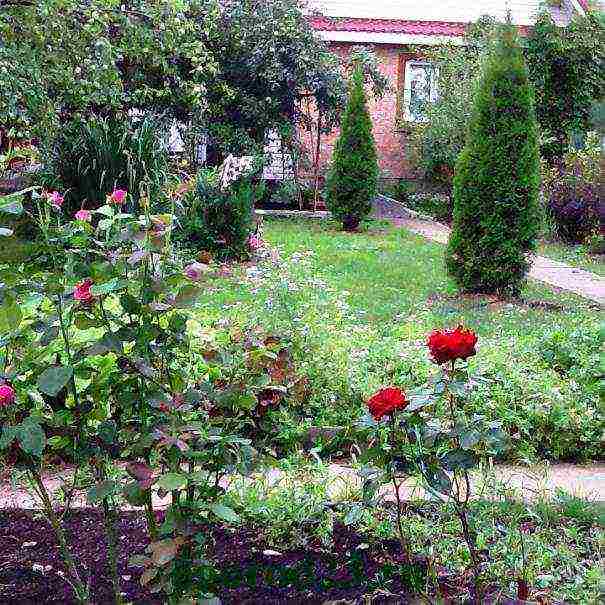
Thuja differs from pine or spruce in that it has no needles, its branches are covered with small green scales, soft, pleasant to the touch. It is tacitly called the "royal tree" - it is well deserved. We will consider the nuances of planting, caring for the coniferous beauty thuja, so that it takes root on your site too.
↑ to contents ↑ Thuja tree - selection of seedlings
If you do not plan to reproduce thuja independently, then you can purchase ready-made, grown seedlings.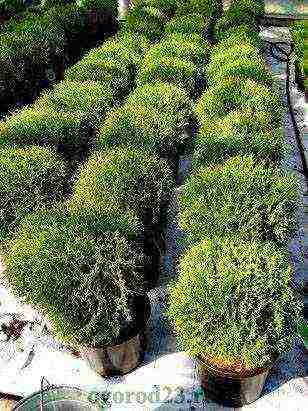 They can be purchased at ephedra nurseries or in a specialized store. There, among the declared assortment, you will choose the desired variety, buy a healthy tree adapted to the local climate.
They can be purchased at ephedra nurseries or in a specialized store. There, among the declared assortment, you will choose the desired variety, buy a healthy tree adapted to the local climate.
Small thuja from nurseries vary in size and age. If you have a small seedling, then it will not be difficult to "grow" it yourself until it is planted in a permanent place of growth. You can also purchase a large copy, ready for the decoration of the site or the local area.
When choosing, always pay attention to the conditions of the plants, the degree of soil moisture in the containers, the strength of the coniferous scales on the branch. The branches of the seedlings should be elastic, the needles should not crumble, they should not have any spots or signs of disease. Upon arrival home, hurry up to transplant them to a shaded place, water.
↑ back to contents ↑ Planting thuja in the ground
Thuja will perfectly take root on your site at any time of the year, except in late autumn or winter. Experienced gardeners advise exactly the spring period - April, May. Planted in spring, it will hurt less, grow faster, and adapt better to the environment.
The landing site should be slightly shaded, consider this factor when planning the landscape design of the site. In direct sunlight, the tree will wither, and subsequently it will be worse to endure the winter cold. In a completely dark place, thuja will slowly develop, the branches will not be lush, bright. The ideal territory for it will be a windless section of the site, with light shading, close occurrence of groundwater.
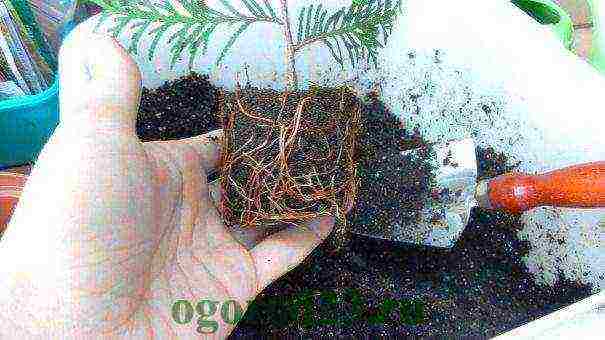
Thuja - planting and leaving, phased actions:
- First, we dig a fairly deep hole - 80-100 cm deep, with the same diameter (if you, of course, have a large seedling, and not the one in the photo above). The deepening should be such that a tree with an earthen lump can freely enter there. At the bottom we pour a little earth mixed with wood ash or other organic fertilizer.
- We put it in a hole, while its root collar should be at the same level with the soil surface.
- Mix the dug earth with sand, peat (1: 1), fill a depression with a seedling with this mixture, and then slightly trample.
The distance between the trees should be determined according to the characteristics of the variety, since thuja are very small and, conversely, very tall. Small trees can be planted a meter apart, large trees about 4-5 meters.Some varieties of thuja reach 15-20 meters in height, and their crown grows in breadth up to 3-4 meters (for example, thuja western Brabant). For full development, such a tree needs space, but when decorating alleys, green corridors, hedges, thuja are planted at a distance of 1 meter, regardless of the variety and type.
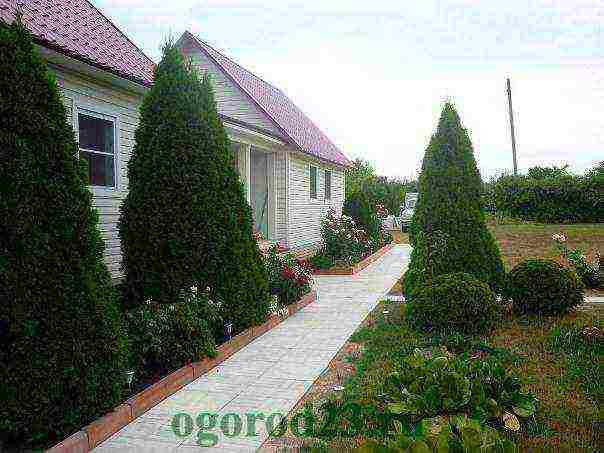 Tui Western Smaragd and globular Danica↑ back to contents ↑ How to care for thuja
Tui Western Smaragd and globular Danica↑ back to contents ↑ How to care for thuja
Competent care of this ephedra implies watering, feeding, loosening the trunk circle, and forming a crown. After the tree is planted at its permanent place of residence, primary feeding is done. For these purposes, natural growth stimulants are often used (most gardeners choose "Epin"). The ingredients of such dressings contribute to better rooting of the tree, improve resistance to diseases. In the spring, you can feed it with potassium-phosphorus supplements, it is better to do this twice, the break between fertilizers should be 10-15 days.
In spring, the frequency of irrigation is influenced by the amount of rain, with the onset of summer it is enough 2 times a week, in the spring - 1 time. If the rains are frequent, then there is no need to water, there will be enough rain moisture. Thuja requires high-quality watering at all stages of life (seedling, adult tree), while the crown also loves irrigation. In order for the branches to be elastic, shiny, to please you with the brightness of green shades, the minimum amount of water for the root area should be 10 liters per watering (once a week, if the summer is very dry, then up to 3 times). Determine the lack of moisture by the state of the top of the thuja - it begins to turn yellow. It is better to water the trees early in the morning or in the evening.
Tuya is very fond of irrigating the crown, for these procedures, the acquisition of a special nozzle becomes relevant. From such sprinkling, dust is washed off, a fresher appearance of the tree is provided, a pleasant coniferous aroma begins to stand out. Do not be afraid to overdo it with irrigation, 1-2 times a day will only benefit thuja.
Returning to fertilizers, it is worth noting that too frequent fertilizing for thuja is not required. Special mineral compositions for conifers (for example, "Fertika") or compost, which has already become a classic additive, is sufficient to use twice a season - in spring and summer. Fertilizers are applied during loosening: they are laid out in a near-trunk circle, and during plowing they are mixed with the top layer of the soil. In summer, the additive can be diluted with water and used for irrigation.
The near-trunk area must be periodically cleaned of weeds, loosened, mulched with sawdust or compost. Decoratively painted sawdust (they are painted with natural ingredients) or nutshells look very attractive. Mulching creates some barrier to weeds, retains moisture, and improves the condition of the tree as a whole.
As for a haircut or artistic pruning, it is better not to touch it for the first two years of a tree's life, it should take root in its place. You can start caring for the crown from the third year from the moment of planting. Initially, dried, weak branches are removed, and the degree of density is determined. Excessive thinning negatively affects the decorative qualities of the tree, everything should be in moderation.
The main pruning is carried out in April, and then only the shape is corrected. For high-quality air circulation, maintaining the "vigorous" appearance of thuja, gardeners recommend removing all branches of annual growth.
If the artistic intention requires the tree to grow in breadth, then only the upper part of the crown should be trimmed. From tui, you can create various geometric shapes, columns, figures of animals or fairy-tale characters. For beginner gardeners, it is quite easy to give the crown of a tree the shape of a ball, cascade, border. Trimming or pruning is best done in dry weather.
↑ to contents ↑ Tuya - preparation for winter
For colder regions of the country, frost-resistant varieties of tui (western) should be chosen. Despite their unpretentiousness, they also require preparation for the cold season. In the fall, it is necessary to provide the trees with abundant watering, since even in winter the thuja continues to develop, albeit at a slower pace.
In the first years of life, young representatives must be insulated. With the help of a dense plastic film, non-woven spunbond or other suitable covering material, a kind of cocoon is formed, which will retain heat and let the sun's rays through. You can even buy special covers designed for this very purpose, they are sold by the garden departments of supermarkets or online stores.
For the winter, the roots are covered with fallen leaves, which are harvested with the onset of spring, as soon as the upper layer of the earth thaws. The overgrown crowns of adult thujas are neatly tied with a wide ribbon to prevent the accumulation of snow on the branches.
To please the eye, there was a healthy thuja, planting and care in the open field should be done competently, in a timely manner. This tree is quite unpretentious, but the result of simple care is expressed not only by its external beauty, decoration of the territory. A green hedge made of thuja will absorb noise from the street, neighboring territories, and also protect your site from prying eyes.
Experienced gardeners have long been using not only beautiful, but also useful plants and shrubs for planting in their summer cottage. Thus, thuja gained popularity - an evergreen perennial plant that releases phytoncides into the atmosphere, which have antimicrobial properties.
Planting and caring for thuja outdoors for experienced gardeners is not difficult. That is why thuja can also be planted at home, where the features of care may differ slightly.

Content
Types and varieties of thuja
There are a huge number of species and varieties of the presented plant. There are 5 main types, which include:
- Chinese;
- Korean;
- Japanese;
- west;
- folded.
Each of the species includes up to several dozen varieties, but only the most unpretentious representatives are suitable for growing in garden plots.
The following are distinguished here:
Thuja spherical
- it was due to the shape of the crown that it received its portion of popularity in cultivation in summer cottages.
Danike is one of the most popular varieties with a spherical crown.
... They prefer to plant it near gazebos or try to dilute the created woody composition. This variety reaches a height of
60 cm
, which makes it attractive in appearance and easy to clean.
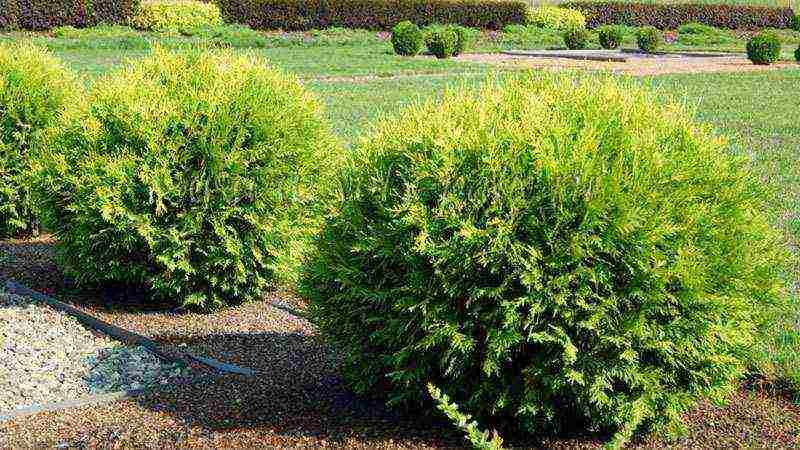 Thuja Brabant
Thuja Brabant
- a cone-shaped plant variety that can grow 40 cm in height and increase in size up to 15 cm in diameter in a year. This variety, when grown in summer cottages in Russia, can reach a height of all
or even
5 m
... Therefore, it is used less often. Such bushes can be found in the garden plots of elite residences, where thuja plays the role of a hedge.
 Thuja Smaragd
Thuja Smaragd
- the same conical crown shape attracts most gardeners. An adult bush in diameter reaches
2 m
... The crown is quite dense, so it can also be used as a hedge. The presented variety pleases with its longevity - the shrub can grow up to 150 years.
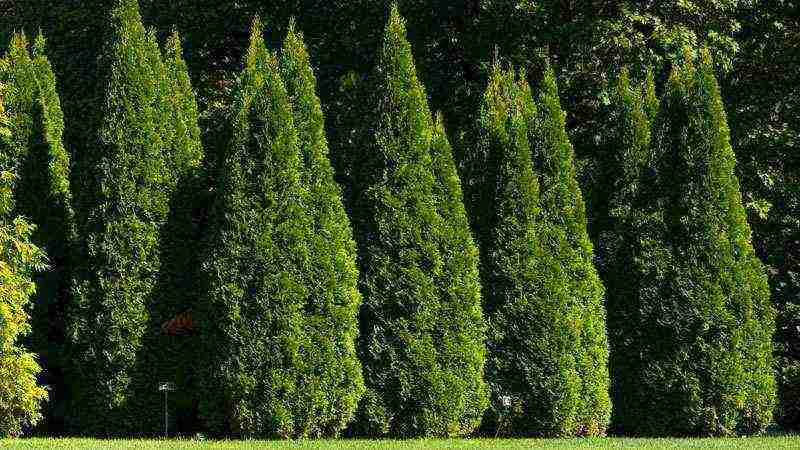
Each type and variety of thuja Deserves attention. They need to be studied due to the need or desire to plant a particular variety in the garden. Such actions are necessary for the normal and full growth of the plant.
Which is better: juniper or thuja? Video:
Breeding methods and cultivation features
The shrub is grown at home, and only then planted in open ground in the garden.
You can use a simple and easier way - to purchase a ready-made seedling, which must be planted immediately after purchase. But self-cultivation is much more interesting.
So, you can grow thuja from a seed or from a selected cuttings. Both methods are worthy of detailed consideration.
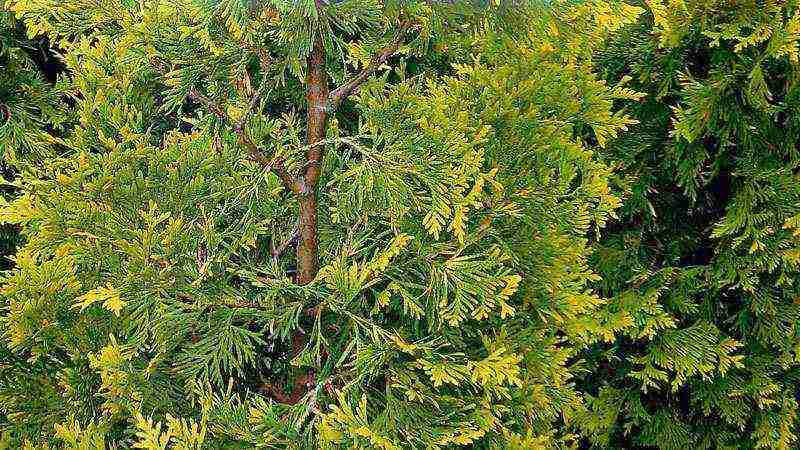
Growing a seedling from seed
If you are new to gardening, then the question is, how to grow thuja from seeds, should be considered in more detail. The seeds of the presented plant can be purchased at a specialized store or you can get it yourself.
Thuja has woody cones, from which seeds are extracted from September to December.
Cones are placed in a ventilated place under diffused light. After a while, they open, and you can safely remove the seeds.
Further growing thuja from seeds at home happens as follows:
1. The first method of planting seeds involves using a regular flower pot and soil mixed with peat and humus.
Previously, the seeds are kept for a day in a damp cloth. You should not plant the seeds deeply, just sprinkle them with earth or sawdust on top.
As necessary, the planted seeds are watered (with drying out of the soil) and kept under diffused light. Sprouts should be planted with warming up the soil in the garden in the spring.
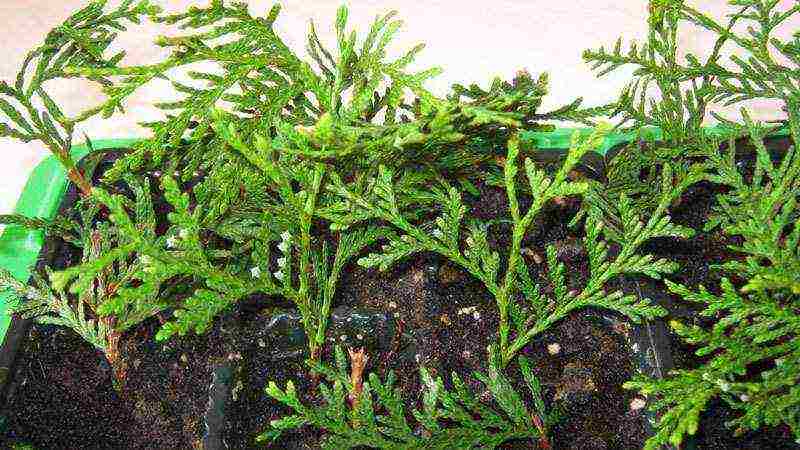
2. The second method of planting seeds gives a germination rate of about 90%. Here, in September, you should remove the seeds from the cones and put them in a bag, which must be stored in a cool place until it snows.
As soon as the snow completely covers the earth's surface, the seeds are buried in snowdrifts and kept there until spring. In the spring, it is already possible to plant the preserved thuja seeds also shallowly into the soil of the garden plot at a distance of 10 cm. It is important to water the garden abundantly.
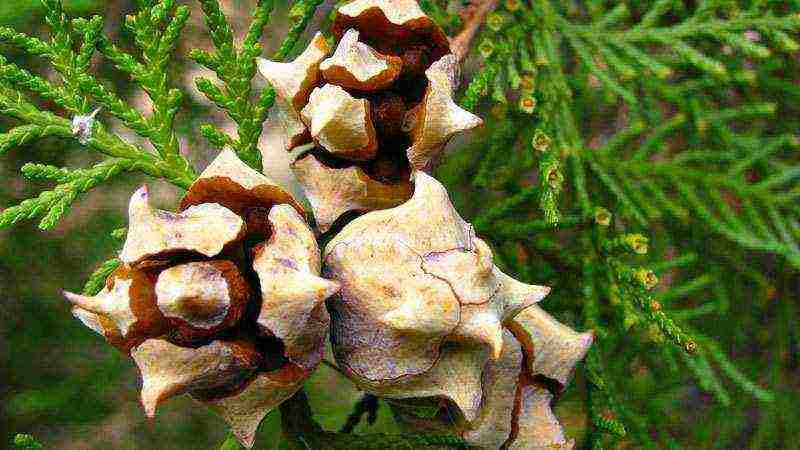
Thus, sprouts grow for 3 years, taking care of them properly - removing weeds and regularly watering as the soil dries up. In the fourth spring, you can plant the sprouts in a permanent place.
From the above, it becomes clear that such a cultivation takes a long time.
Therefore, gardeners resort to the second method of self-growing seedlings using cuttings.
Growing a seedling from a twig
How to grow thuja from a twig, if there is no plant presented on your garden plot?
In April, when the buds are ripe on the branches of the plants, visit a fruit tree nursery or visit your neighbors whose garden is decorated with this unique and interesting shrub. Ask to cut a lignified stalk about 40 cm in size.
Then you will need to perform the following actions:
- Divide the stalk yourself into 2-4 specimens so that each of them has a part of the mother bark.
- The resulting branches must be treated with any solution that stimulates rooting, and left for 12 hours to process.
- Prepare the soil in your garden - add some peat and sand to the soil.
- Plant the cuttings into the ground to a depth of no more than 3 cm.
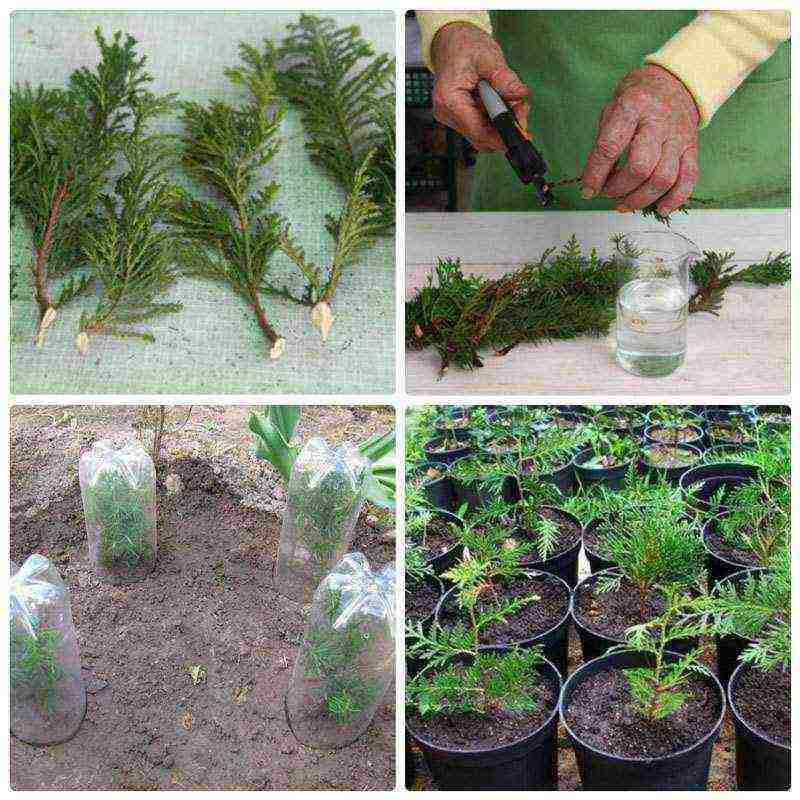
- The soil should be well moistened, but also do not forget about spraying - this is an important condition in the presented method of growing a seedling. When the cuttings are rooted, watering is significantly reduced.
- For the winter, new mini-shrubs are covered with polyethylene if the planting took place in a region with a harsh climate. In other cases, it will be enough to cover with fallen leaves or spruce branches.
Similar thuja propagation by cuttings can be done at home. Branches are planted in a container with soil and covered with a greenhouse - such an action will lead to faster growth.
Just do not forget about the appropriate daily airing, watering and spraying until the cuttings are completely rooted.
How to propagate and grow thuja, video:
Correct planting and care of thuja outdoors
Thuja planting depends on the size of self-grown seedlings. If an acquired plant is planted, then this is done according to the following principles:
- A place for further growth of thuja should have a beneficial effect on the growth of the plant - it is a sunny place, protected from the winds. You should not choose a place on the site that is constantly exposed to direct sunlight - the plant will begin to wither. Also, you can not plant a shrub in the shade - it will begin to thin out.
- The dimensions of the dug hole for planting depend only on the existing root system. The diameter of the planting pit can be up to a meter.
- A layer of stones is laid at the bottom of the hole as drainage - the presented plant does not tolerate stagnant water well.
- A layer of soil is laid on top of the stones, where turf, peat and sand are mixed in equal quantities.
- Now you should set the seedling so that the root collar is at the level of the soil.
- "Fix" the seedling with the remaining soil or turf soil.
- After planting, the seedlings can be watered with a moderate amount of water.
When planting, the distance between the seedlings should be observed. Depending on the variety, it can reach from 2 to 5 m. Consider the possible diameter of the type of shrub used.
This is especially necessary to do if it is implied thuja hedge... In this case, the distance is calculated without taking into account the free space between the future grown bushes.

As for the care of thuja in the open field, difficulties are not foreseen here. It is important to regularly water the shrub, which is done as the soil dries. Periodically, the soil can be hilled, and it is also necessary to constantly remove the weed.
Top dressing of the plant is carried out in early spring, when snow covers the surface of the soil. At this time, nitrogen fertilizers are used.
Such procedures are carried out until mid-summer no more than 2 times a month. Next, you should resort to the use of potash fertilizers, feeding which is extended until late autumn.
At 2-3 years of age, thuja shrubs may require pruning, the whole principle of which is to give an attractive and correct crown for this shrub.
As a rule, in the early years, pruning is only preventive. The complete formation of the bush is carried out already in adult specimens.
How to plant thuja correctly, video:
Thuja: home care
In the absence of your own garden plot, you can grow a small miniature tree at home. Thuja in a pot today it does not seem strange, but quite an adequate solution for those flower growers who want to have a coniferous plant in their home.
There are no additional aspects of care here. It is only important to carry out timely watering and provide the plant with fertile and nutritious soil.
For planting the presented plant at home, choose the eastern thuja and the Ploskovetochnik variety. Planting a plant for self-cultivation in a pot is carried out according to the same principle as described above.
An exception is the absence of a transplantation point to a permanent place - after planting a seed or cutting in a pot with soil, the plant remains in place until fully ripe. The small volume of the container will not allow the shrub to grow as high and wide as possible.

Principle, how to care for thuja at home, is enclosed in the following order:
- Planting a plant in a pot requires good drainage at the bottom of the pot. You can use a regular tray, which will also help remove excess moisture.
- The soil can be enriched with useful microelements by mixing four parts of sod land with two parts of coniferous. Only part of the sand is added to the mixture - the result is a soil suitable for planting seeds or cutting.
- The pot must be placed on the north or west window - this will provide diffused light suitable for normal growth for the shrub.
- For optimal cultivation, an already mature tree is provided with a temperature of 10-15 ° C. In the summer, it is necessary to take the pot with the plant to the balcony so that it receives its portion of air procedures.
- Watering is carried out as needed as soon as the soil dries out. It is important not to allow excessive moisture or dry out of the soil, all this will lead to the death of the plant.
- Thuja can calmly tolerate any whims of air humidity in the room. However, excessive "air drying" should not be allowed. It is better to maintain a moderate climate in relation to indoor humidity. In summer, in the heat, the plant should be sprayed.
- For the normal formation of a bush, the plant is pruned.
When growing thuja, one should not forget about timely feeding with special universal fertilizers, which are carried out in the spring and during the summer for a favorable and rapid growth.
From August to September, you can start propagation by cuttings.
Self-forming bonsai
Surprisingly, some growers give the bush-like thuja the shape of a bonsai tree. This is not easy to do. It is not enough just to pinch and cut the plant.
To form a bonsai, it is necessary to give the shrub an appropriate shape, subjecting its branches to a forced change in the direction of growth, slightly breaking them at the same time. The curved branch is fixed in a new direction and all branches are cut off.
After a while, the shrub will begin to form into a bonsai tree, where you should monitor the formation of the crown, constantly pruning.
Pay attention to this material - Barberry: planting and care, useful properties.
Diseases and pests
Proper care of the presented plant allows you to achieve an attractive green shrub.
If you make any mistakes, the thuja branches can thin out, and the rich green color will change to pale gray.
But this is not the worst thing that can happen to a plant. Much more dangerous is a fungal infection or an invasion of harmful insects, the fight against which can take a long time. The most common and dangerous diseases of thuja include:
You will be interested in this article - Black currant: planting and care in the open field.
- Fungus - appears in the form of spots characteristic of the fungus, often affecting young shoots. The shrub should be treated immediately. To begin with, all affected areas are completely cut off, and then you can resort to treatment with any antifungal solution.
- False shield - yellow spots form on the branches, which are often perceived as a real shield. To remove them, the plant should be treated with Rogor or Karbofos solutions.
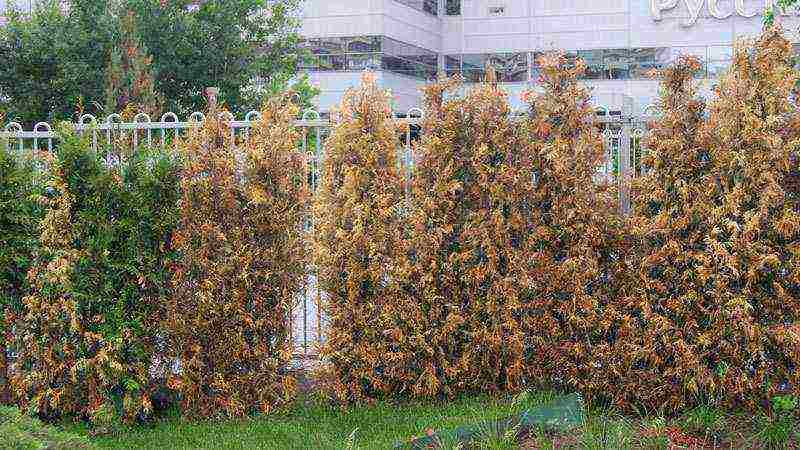
- Speckled moth - often appears when growing thuja in the open field. It manifests itself in the form of the transformation of branches into brown color and the withering away of the top of the tree. You can get rid of pests by treating the shrub with solutions containing pyrethroid.
- Aphids - leads to the fall of the needles from the bush. Here you can use Karbofos according to the instructions.
The correct cultivation of a coniferous plant at home or in the open field will give flower growers and gardeners great pleasure.
Such plants should be "kept" nearby, as thuja needles have excellent beneficial properties.
Thuja needles can be used to treat wounds, as a hemostatic agent, and also for colds.
Like the article ? Show it to your friends:
Ephedra are very popular for decoration, both in the city part and in private estates, decorating the territory throughout the year. Among the variety of coniferous representatives of thuja, planting and care in the open field for which they do not require large labor costs, is the biggest favorite of landscape designers and summer residents.
Common plant varieties

The genus of evergreen shrubs, and sometimes trees, belonging to the Cypress family, includes 5 species:
- thuja western;
- thuja Korean;
- thuja folded;
- Japanese thuja;
- thuja sichuan.
The most common variety that can be found in park areas, near the entrances to administrative buildings and in private territories is thuja western, characterized by slow growth rates, resistance to frost and winds.
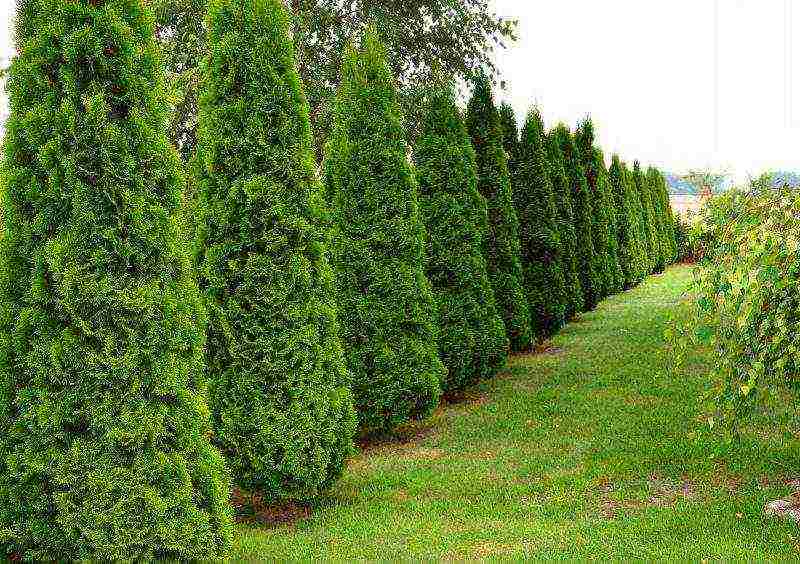
Of the many and varied varieties of evergreen long-liver, the following stand out:
- "Smaragd" is a low-growing cone-shaped bush, not exceeding 2 m, with weak branching. The branches grow vertically, being at a considerable distance from each other.
- "Brabant" is a cone-shaped variety with a significant height of 15-21 m, at which the diameter of the widest section of the crown can reach 4 m.
- "Danica" is a spherical dwarf thuja with a peeling bark of a reddish color. With the onset of winter, the green scales of the needles are set off with a light brownish tone.
- "Woodward" is a low-growing form of a spherical conifer, distinguished by its insignificant maximum dimensions - height - 2.5 m, width - 5 m.
Landing in open ground
Despite the unpretentiousness of the thuja, the evergreen beauty needs a competent approach already at the planting stage, on which the success of the further cultivation of the plant largely depends.
How to choose the right seedlings?
Planting material should be purchased in nurseries or specialized points of sale, focusing on the purpose of the purchase: adult specimens are immediately purchased to decorate the site, and if there is time, then you can opt for young plants, which also take root well. When choosing a seedling, it is examined for the presence of spots, lesions by diseases and pests.
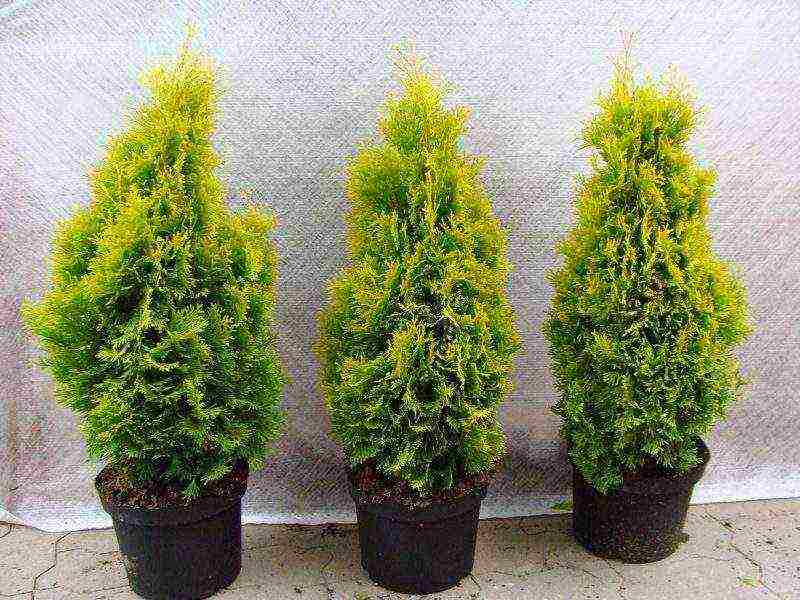
Important! High-quality planting material should have elastic shoots with well-kept needles and a moist rhizome.
Soil preparation and site
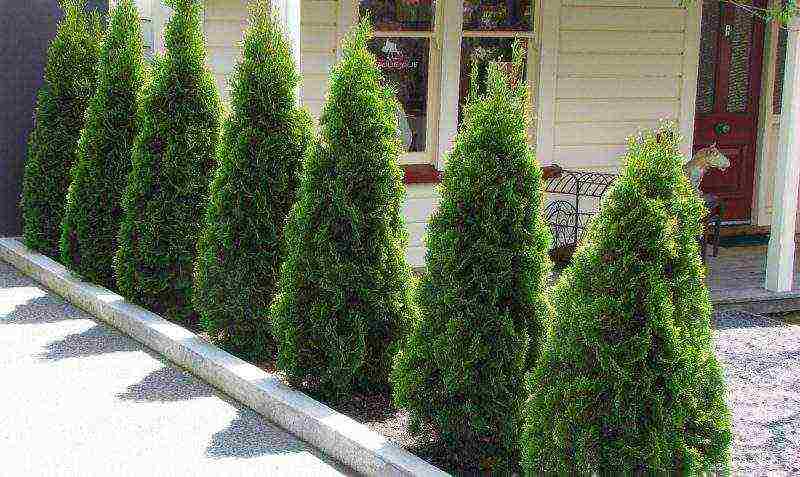
The site for thuja is selected with little shading: direct sun access leads to drying of the shoots, which negatively affects wintering, and an excess of shade harms the decorative qualities of the ephedra, expressed in growth retardation, loss of intense color and splendor. A high level of groundwater is not afraid of thuja, however, in combination with heavy soils, stagnation of water can be observed, which is not permissible when growing a crop. In this case, a drainage layer of 15 cm from crushed brick is placed on the bottom of the hole.The culture is undemanding to the composition of the soil, while preferring a loose and fertile soil, consisting of fertile soil, peat and sand in equal parts.
How and when to plant?
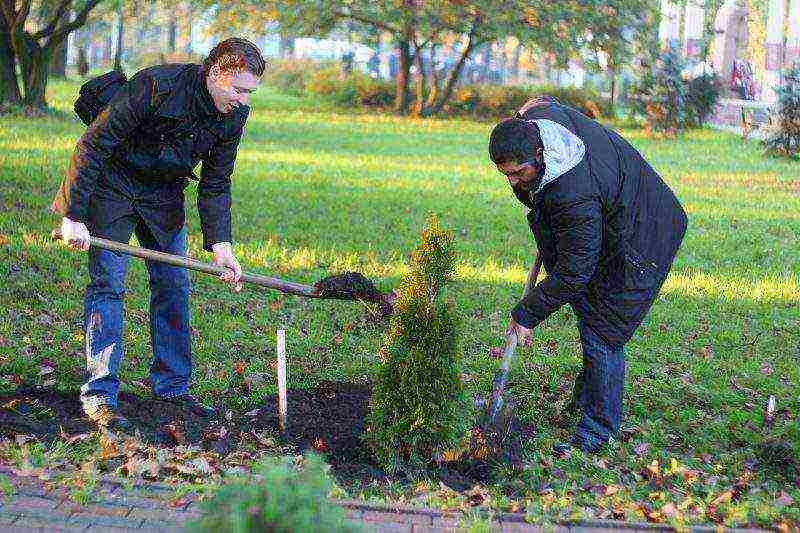
The timing of planting seedlings is extended: the procedure is carried out from spring to autumn. The optimal time is considered the second half of spring, when the planted bushes are able to quickly adapt to the new environment and take root. Planting a thuja in the fall has certain risks due to the uncertainty that the plant will have enough time to take root in the chosen place before the onset of cold weather.
Landing is carried out according to the following scheme:
- Planting holes are dug at a certain distance, depending on the characteristics of the variety and the purpose, of such a size that the plants are freely placed in them along with the soil clod.
- At the bottom of the hole, a drainage layer is organized, which is sprinkled with a small amount of soil with wood ash and organic matter in the form of compost.
- The seedling is lowered into the hole so that the root collar is flush with the earth's surface.
- Thuja is covered with a substrate of earth, sand, peat.
- The soil around the trunk is compacted and watered well.
Advice! With an open rhizome, the ephedra is planted in the spring for successful rooting. Plants are planted from containers with soil mixture throughout the growing season.
Thuja: outdoor care
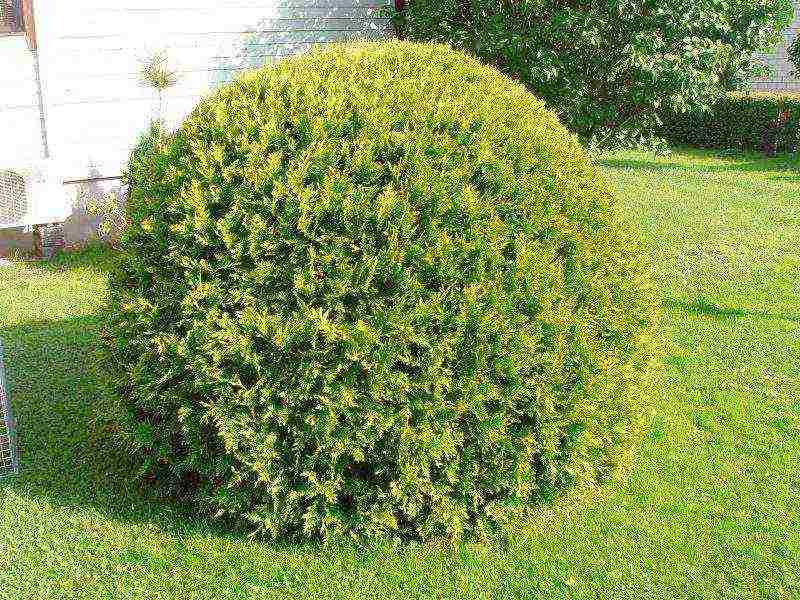
Competent care of thuja provides for the implementation of a set of measures designed for the full growth of the bush.
Watering, loosening and mulching
Ephedra responds well to watering, especially sprinkling. Only a planted seedling must be watered every week with a volume of water of 10-50 liters, depending on its size. In the case of sprinkling, not only the earth is moistened, but dust is also removed from the crown, thereby providing the plant with free access to air and accelerating all physiological processes. After irrigation, the soil in the near-trunk circle is loosened to a depth of 10 cm so as not to damage the surface roots. Mulching is carried out using peat, compost or pine bark to protect the roots of the plant from overheating or hypothermia.
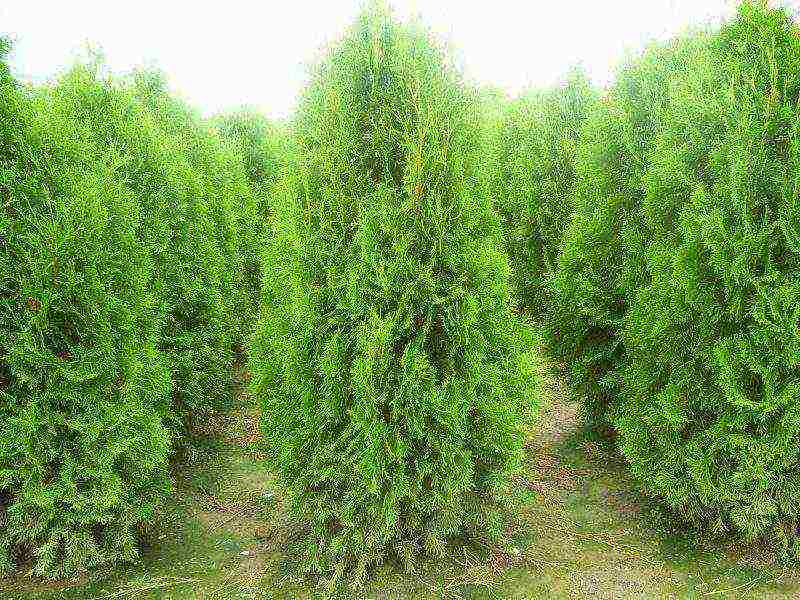
Carefully! The mulch should not cover the trunk or the lower shoots that may begin to rot underneath.
Top dressing
Additional feeding of the ephedra is carried out by the spring application of complex mineral fertilizers with a rate of 50-60 g / m2. If fertilizers were applied during planting, then the first feeding is organized only in the third year of growth.
Crown formation
Pruning stimulates branching of shoots: the more often it is carried out, the greater the density and splendor of the crown. The timing of pruning is not strictly regulated, however, according to experts, it is better to carry out the procedure in early spring before the buds open. Single plantings need a sanitary and thinning haircut.
Formative pruning is required when using thuja as a "green" fence or in group plantings, while:
- The formation of the crown is carried out after the thuja reaches the desired size and age of three years.
- Typically, the plant is pruned twice - in spring and early fall.
- When pruning, it is cut into more than ⅓ part of the shoot, so as not to weaken the plant.
How to transplant correctly?
If it becomes necessary to transfer an ephedra, which easily tolerates a transplant, from one place to another, it is worth considering the age of the bush:
- If the specimen is small, then the soil at a distance of half a meter from the trunk is pierced with a shovel, after which the plant is removed with an earthen clod and transported in a wheelbarrow so as not to destroy the clod.
- Large specimens are stitched a year before moving, so that they have time to grow young roots in a limited area - during this time the soil will bond well, and the procedure will be practically stress-free for the culture.
Preparing for winter
From the middle of autumn, watering and feeding stops, so that the thuja begins to prepare for a state of rest. Young plants, before reaching the age of five, need a shelter of spruce branches, in front of which the plant is huddled, and the near-stem zone is mulched with a thick layer of peat.
Important! Adult specimens do not need to be covered, but mulching, which protects the root from freezing, is required at any age.
Disease and pest control
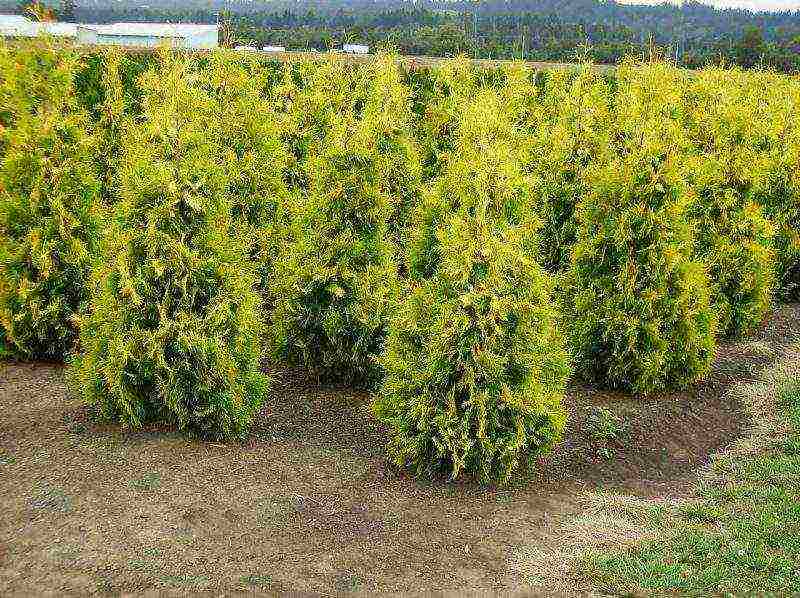
Shoots and needles of a crop are often affected by fungal diseases such as fusarium, shute, cytosporosis. Bordeaux liquid or antifungal fungicides are used as measures to combat the beginning of spring. Three-time treatment is carried out with an interval of half a month. Of the pests on the thuja, false shields and aphids are noted, which often cause yellowing and dumping of needles. For protection, a single treatment with an insecticide is carried out in early spring and after the arrival of summer, double spraying with a two-week time interval.
Reproduction of thuja
Since the varietal characteristics are not preserved with the generative method of reproduction, vegetative methods of breeding thuja are most often used - cuttings and dividing the bush.
Cuttings
To propagate a plant in this way:
- In June, cuttings in the form of lignified three-year shoots 30 cm long or semi-lignified parts of the current season of 15 cm are separated from the mother plant with a heel.
- The separation sites are treated with a rooting stimulant.
- The cuttings are placed in a light and loose substrate, previously disinfected with a solution of potassium permanganate, to a depth of 3 cm.
- Landings are covered with plastic wrap.
- After the formation of roots and hardening of the cuttings, the film is removed, and new plants with a cold snap are covered with dry foliage or sawdust.
Dividing the bush
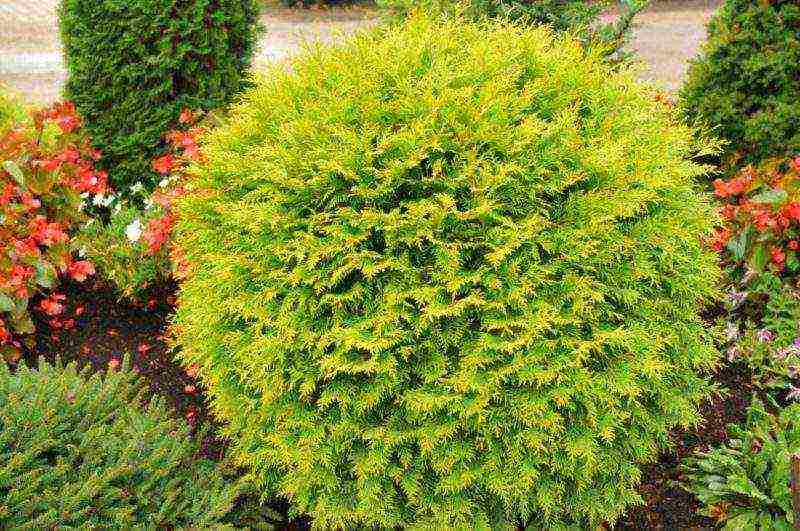
The procedure is advisable to apply to bush undersized forms. For successful reproduction by this method, it is enough to carry out work as during transplantation, but only with a small nuance: the rhizome with an earthen lump is divided into several parts.
Thuja in landscape design
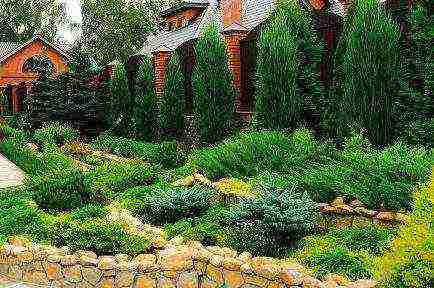
A variety of forms makes it possible for lovers of conifers to implement various ideas for the design of parks, squares and summer cottages:
- Tall varieties are used to form hedges;
- Undersized representatives are excellent for curbs that delimit recreation areas.
- Spherical forms of thuja are often found when decorating alpine slides.
- Group plantings of thuja with needles of different colors contrast perfectly in parks and squares.
- Thuyas are used to decorate patios for air purification.
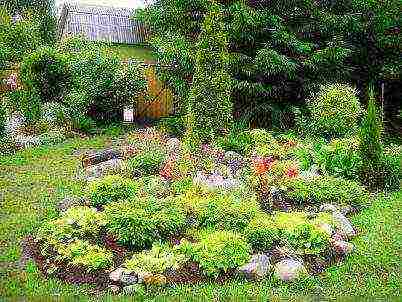
With minimal maintenance, this elegant evergreen tree will grace your garden for years to come.

Among the many coniferous trees, thuja has won the great love of gardeners. It is often used in landscape design, not only urban, but also for the design of summer cottages. The king's tree or thuja is a perennial frost-hardy plant with leaves unusual for conifers in the form of flat scales, which is ideal for creating a hedge or alley. This plant, like many conifers, spreads a wonderful aroma, releasing phytoncides into the environment. If you are interested in this type of tree, then in this article you will find the basic rules for growing, reproduction and thuja care.
Thuja breeding secrets
Reproduction of thuja is possible in three ways:
- growing from seeds;
- planting cuttings (twigs);
- planting ready-made seedlings.
You can experiment by trying to grow thuja in different ways. But, as experienced gardeners say, the most effective, reliable method is propagation by cuttings.
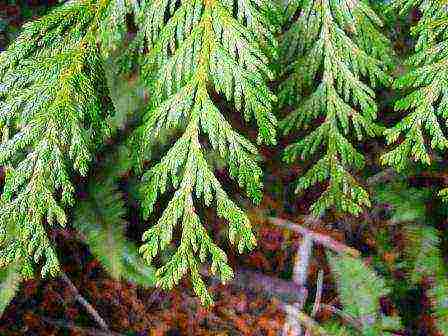
Let's consider all three ways:
1. Growing a thuja from a seed is not very popular, since it is a rather troublesome and long process.A full-fledged, young tree suitable for planting can be obtained only after 5 years. At the same time, there is a high probability of loss of varietal traits, which will lead to the transformation of the seedling into a wild tree. There is one positive point - it turns out a seedling adapted to local conditions.
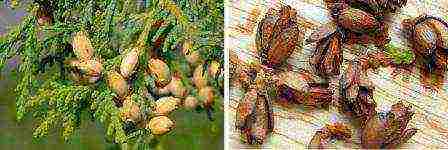
Thuja seeds
To carry out the stratification process, we leave the selected healthy seeds for the winter under the snow, after which they will better sprout and germinate. With the onset of spring, we prepare the box, pour nutrient soil into it, and then sow the seeds. Pour a mixture of earth and coniferous sawdust on top. Young plants are demanding to care for: they need protection from the bright sun, weeding, regular moistening and fertilizing.
2. Propagation by cuttings is the most effective and fastest way to obtain a thuja seedling, and the new tree will retain all varietal characteristics. So, in April we start preparing cuttings. The best option for cutting is a 2 - 3-year-old shoot from the top of the plant. Experienced summer residents recommend harvesting cuttings without a pruner, pulling it out so that a small heel remains - a piece of wood from the donor tree. The size of the cuttings is about 15 - 30 cm. The lower branches, needles are removed from the shoot, disinfected in a weak manganese solution and left for a day in a growth stimulator. At this time, we pour nutrient soil into the boxes, adding sand and peat there. We place the cuttings in the soil with a slight slope, up to 5 cm deep, no more, lightly tamp the earth around and spill it.
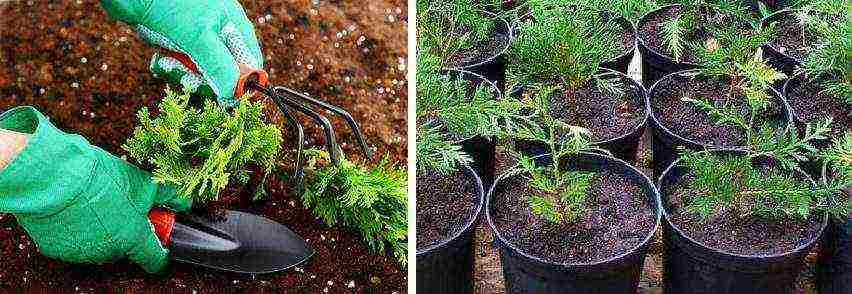
Cuttings root well at an average air temperature of +20, at high humidity, i.e. the ideal location for the first months will be a greenhouse. In the fall, we take cuttings that have already taken root over the summer, and plant them in open ground, not forgetting to cover them before winter. Young trees that have survived the winter are ready for further planting in the selected places.
3. Buying ready-made thuja seedlings is the fastest and easiest way to immediately start decorating the site. This option will be reliable only if you purchase plants in special nurseries, where you will be guaranteed the purity and varietal quality of the products.
When buying seedlings, pay attention to the temperature of the content of the plants, the moisture content of the soil in the pots, the condition of the needles, twigs for diseases. By the way, younger plants take root better. At home, immediately plant the purchased seedlings in a shaded place and shed well.
Spring planting of thuja. How to choose a seat?
Spring is the most favorable period for planting thuja outdoors. Of course, you can plant it at any other time. Thuja is a fairly hardy plant that grows quite well on any piece of land. But, having found the optimal place for growth, you will achieve its best decorative effect.
In too lit places, thuja dries, does not tolerate frosts, in the shade it grows worse, becomes faded, less lush. The best would be to plant a thuja in a shaded place, protected from the winds, with surface groundwater.
Watch the video: How to plant thuja correctly
So, let's move on to the process of planting a thuja:
- we dig a hole, which is 70 cm deep, and has a diameter of about 1 m. The plant with a clod of earth on the roots should easily fit into it.
- We pour organic-enriched soil into the hole.
- We place the plant in the hole so that the root collar is at ground level.
- Mix the main soil, adding peat and sand in equal parts, fill the hole and lightly tamp the surface.
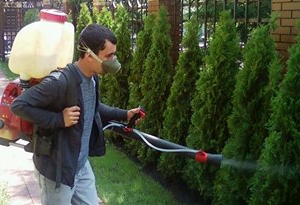
Thuja care
When planting several seedlings, they are placed at a distance from each other, depending on the variety. As a rule, the interval for small-sized varieties is set within one meter, for large, high ones - five meters. Creating a hedge, seedlings, despite the variety, size, are planted 1 m from each other.
Features of growing thuja
Young plants, however, like adults, thrive better in high humidity, so special attention should be paid to regular watering. The minimum water consumption is 10 liters under the root of one tree; in hot weather, the consumption doubles. In the absence of proper watering, the thuja turns yellow, many cones appear. The plant should be watered early in the morning or in the evening.
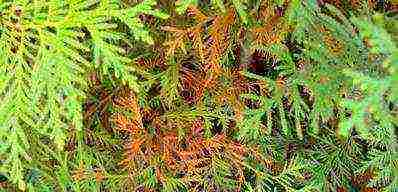
Thuja diseases
I like thuja and such a process as sprinkling - irrigation of branches. The tree is sprayed at the time of watering, while the dust is washed off, the plant becomes clean, elegant, and the air is filled with a pleasant coniferous aroma.
Experienced gardeners are advised to regularly clean the trunk circle, gently loosening it, mulching to maintain a moist environment.
Useful video: Causes of yellowing of thujas. Thuja care
An important point is the timely feeding of the tree, thanks to which it grows more actively, develops, and improves its appearance. Thuja does not require frequent fertilization, it is enough 1 - 2 times a year to make compost, a universal fertilizer for conifers.

Until the age of three, the thuja is not pruned, allowing it to take root well, determining its needs. Starting from the 3rd year, pruning is carried out, dried branches are removed, and given the desired shape. Shoots are cut off no more than 1/3 part. Circumcision is carried out in late spring and early autumn.
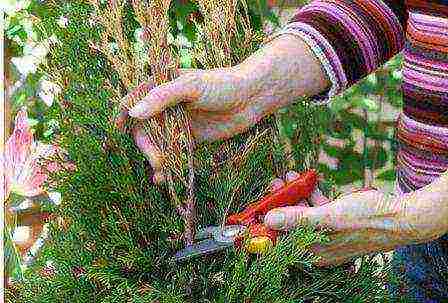
Pruning thuja
Useful article: Do-it-yourself summer cottage crafts for decorating the garden. Photo
Even if you have chosen frost-resistant varieties of thuja, they need preparation for winter. In late autumn, trees shed well. Young specimens are protected with a covering material that allows light to pass through. The roots are covered with fallen leaves. Older trees are not sheltered for the winter, but they need protection from strong winds and snow. For this, the branches are pulled together with a rope and pressed against the trunk, the snow cover is promptly removed. Excessive snow cover causes mold to form.
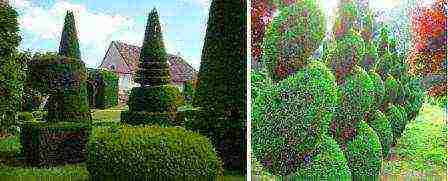
Thuja figures in landscape design
Thuja can become a real decoration of your landscape design and freshen the air with a pleasant aroma. Caring for this tree with your own hands is absolutely easy, so buy ready-made seedlings and equip the area around the house in the best possible way.


